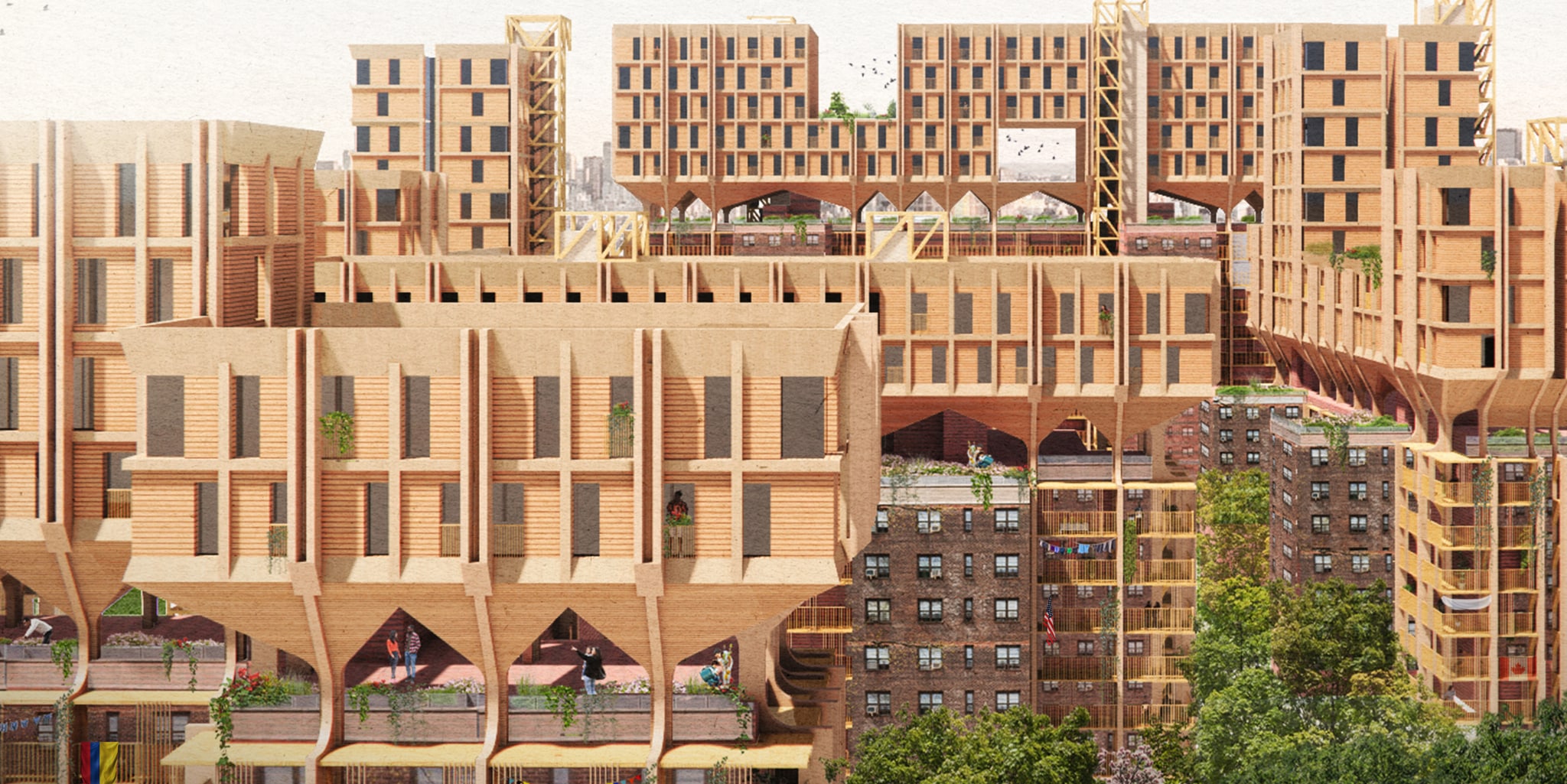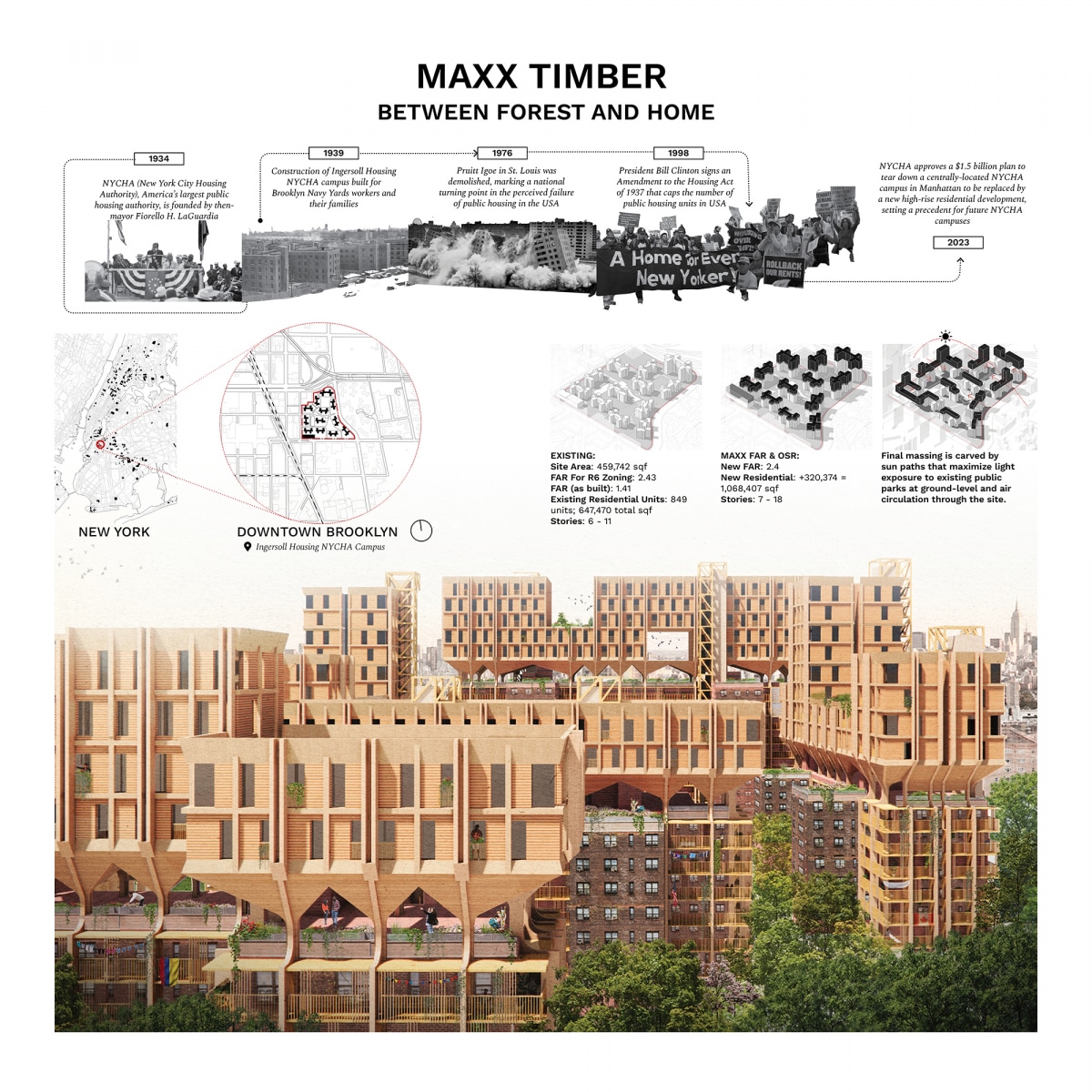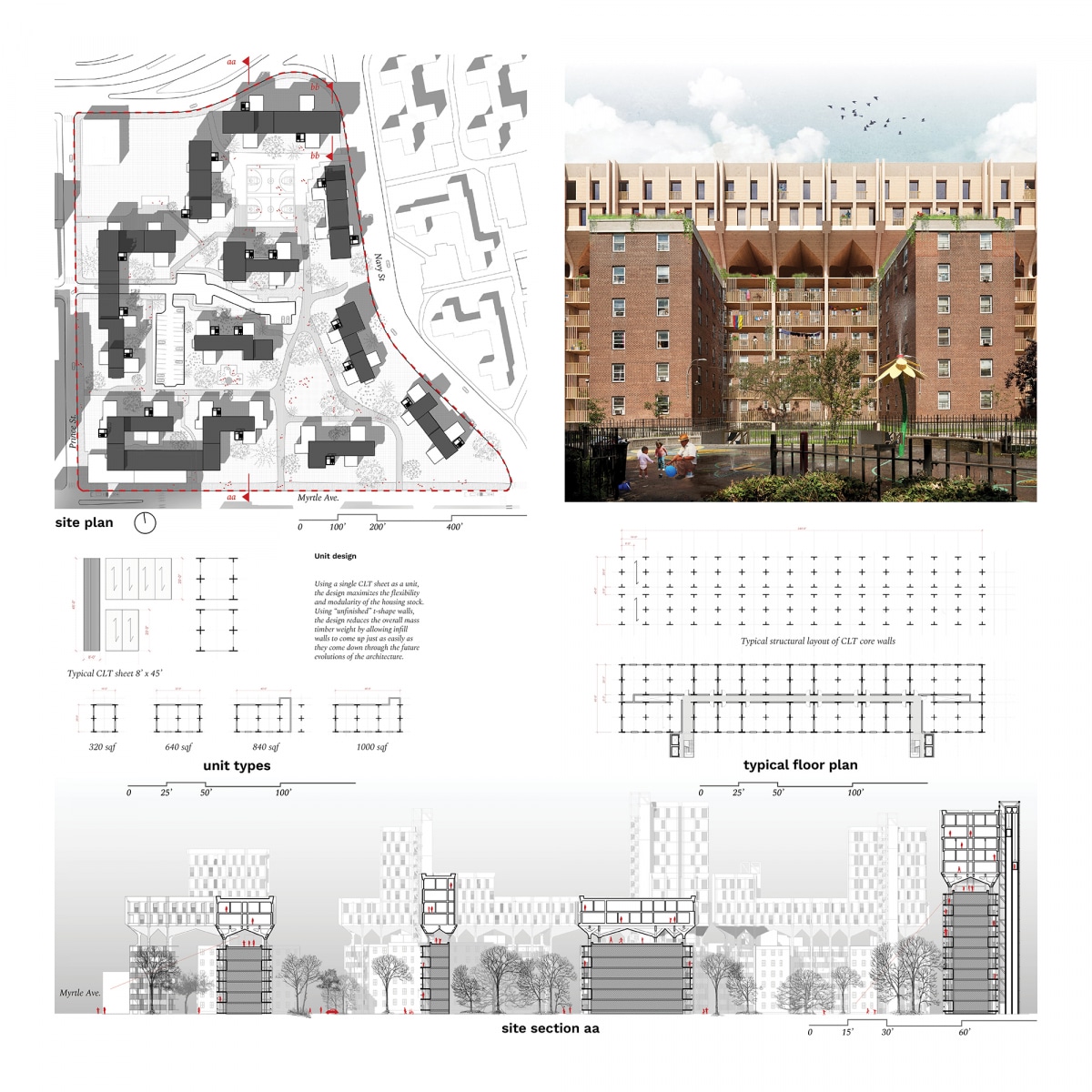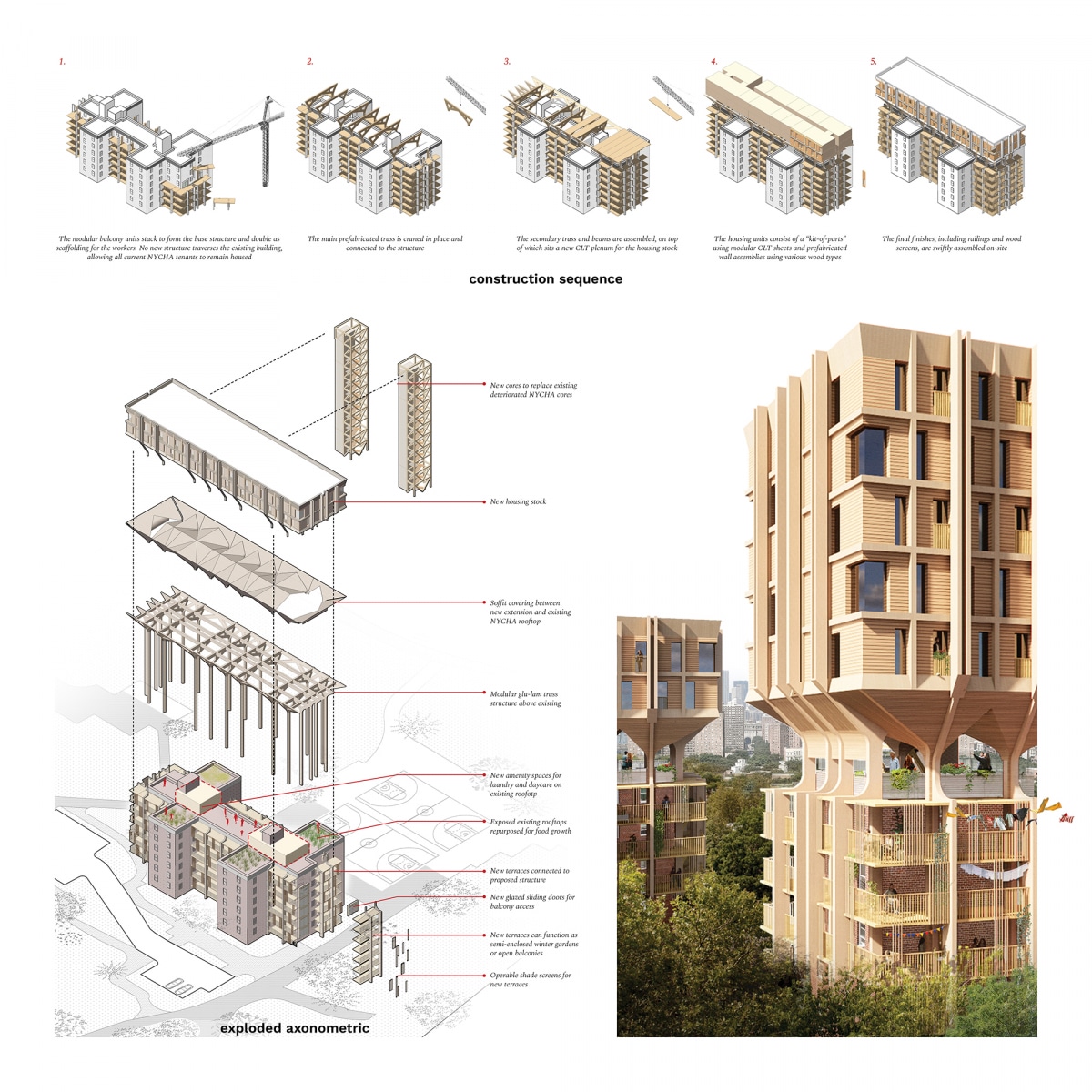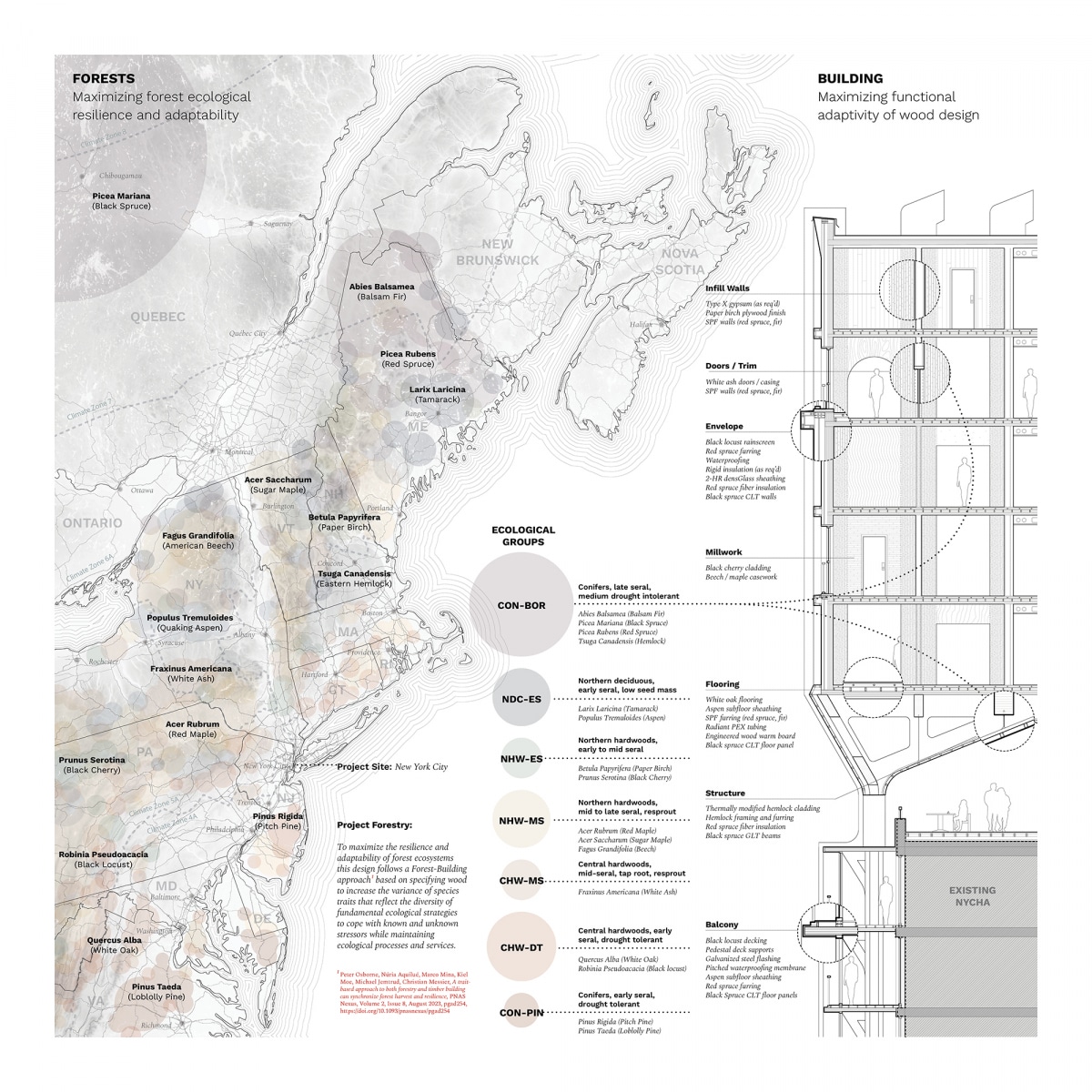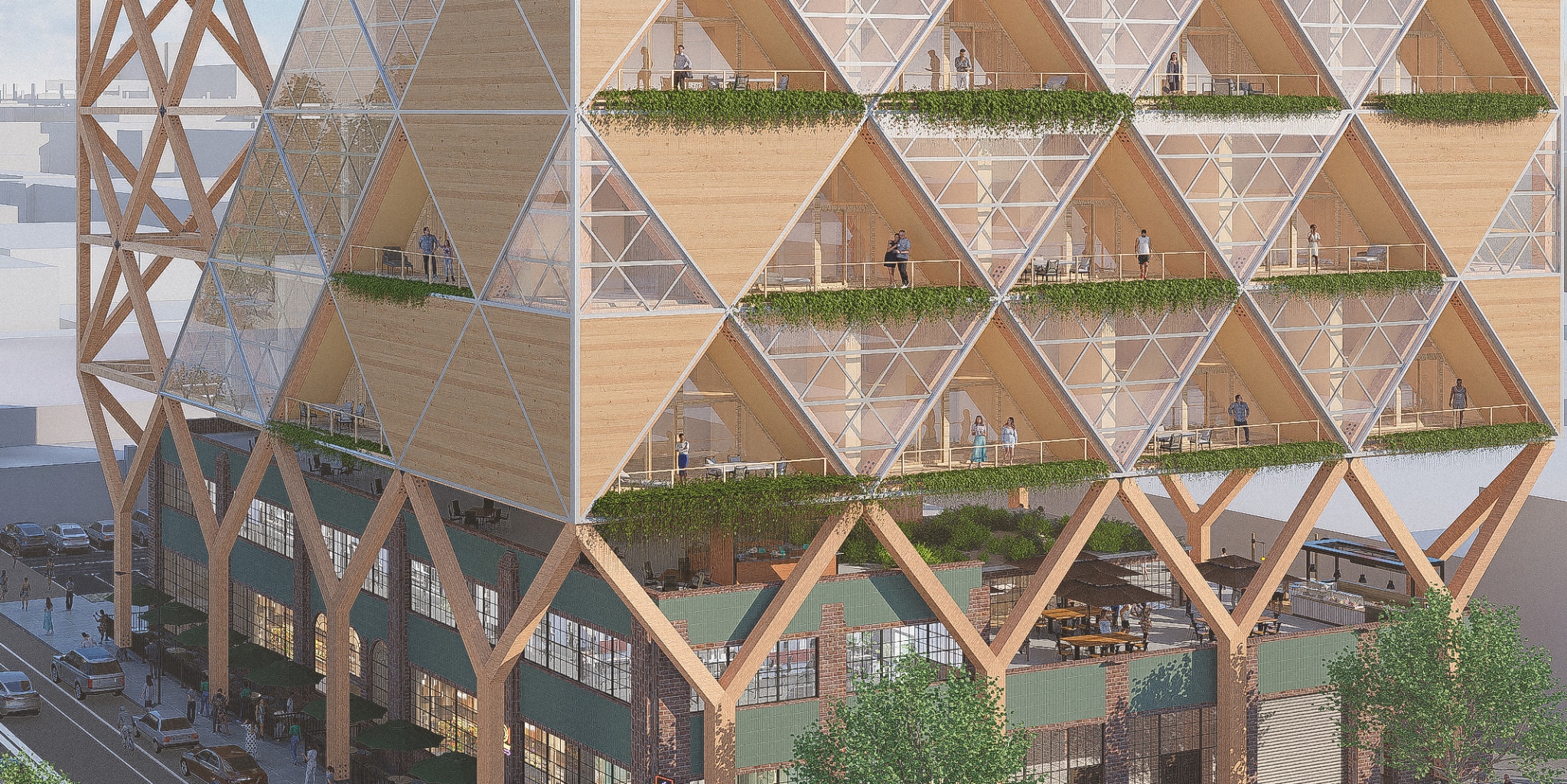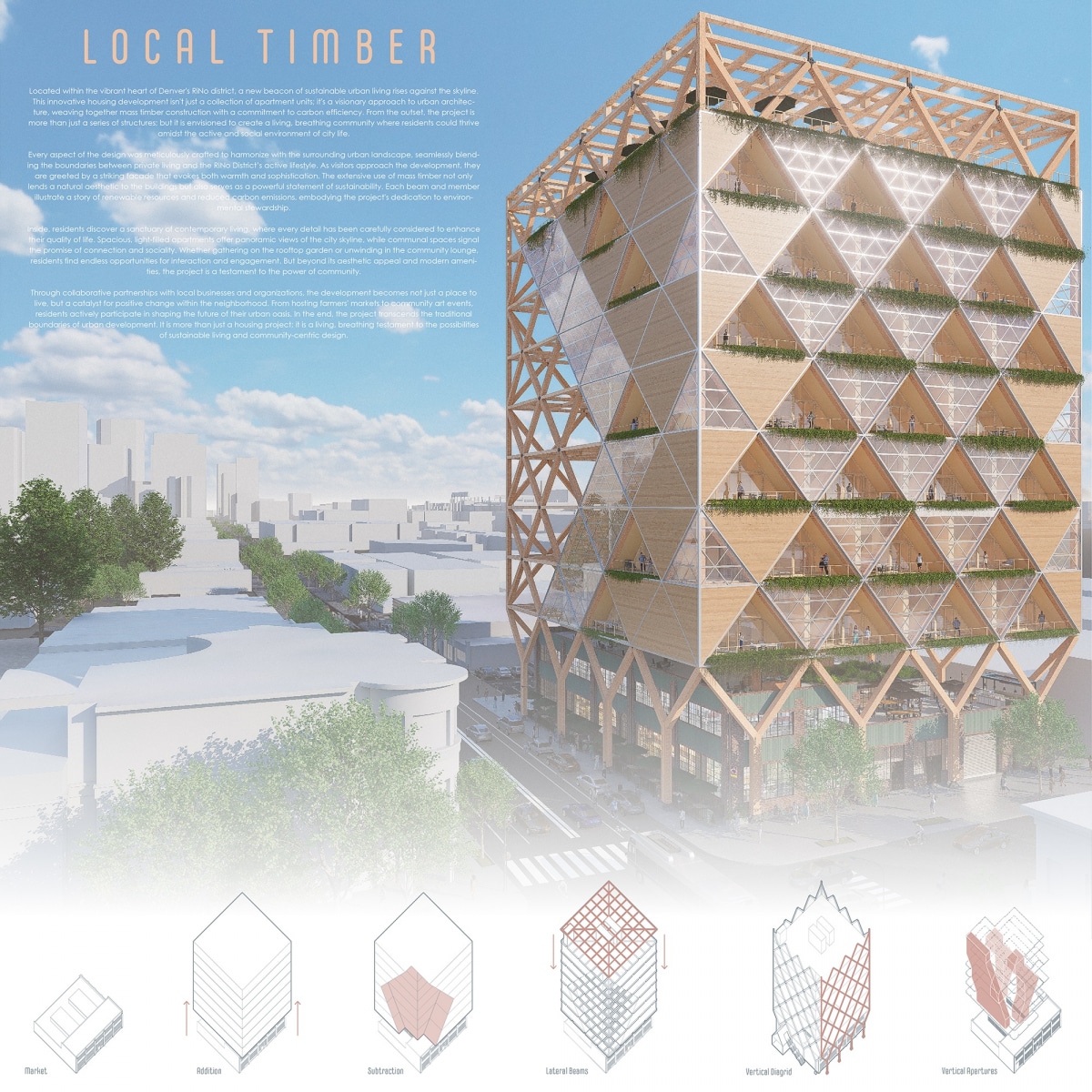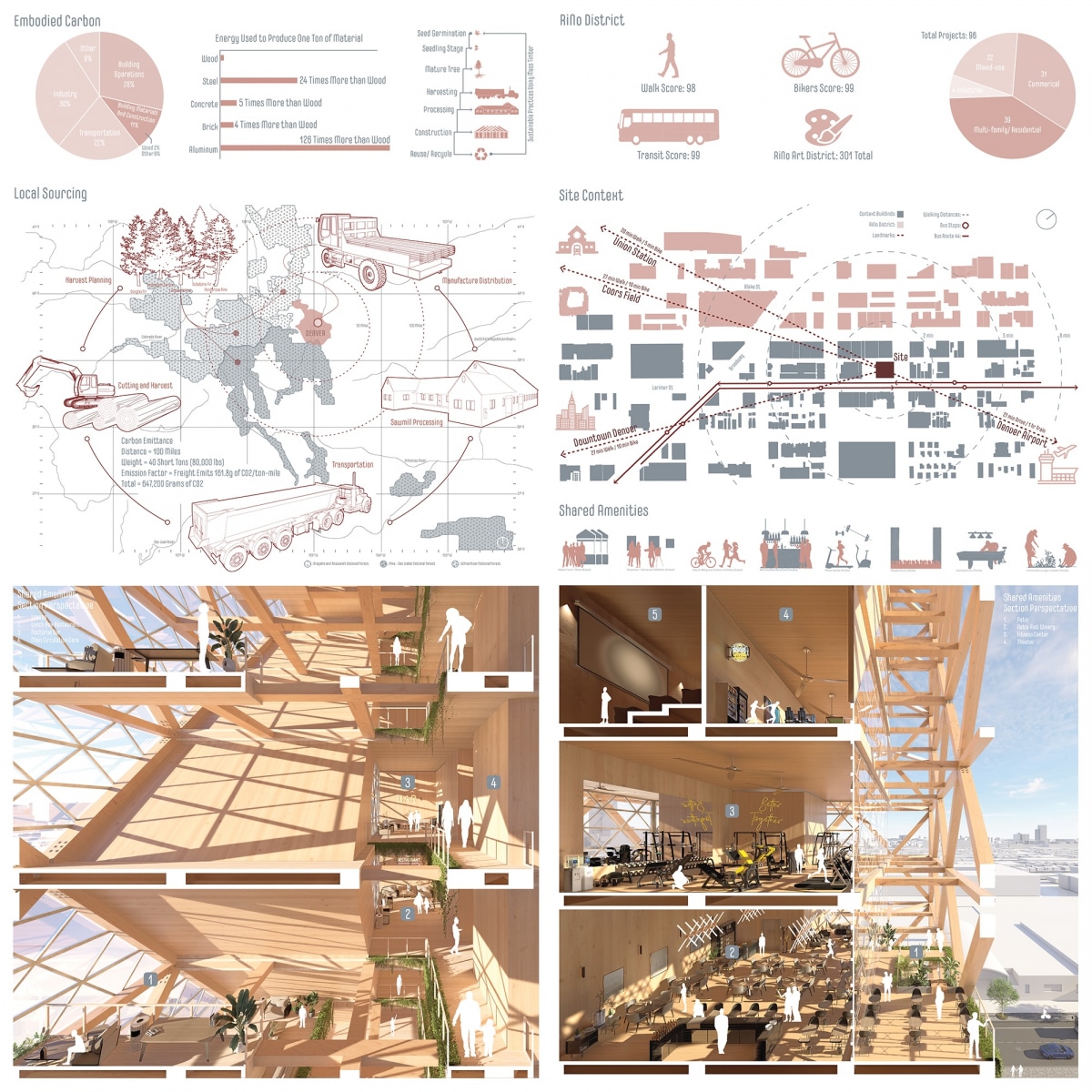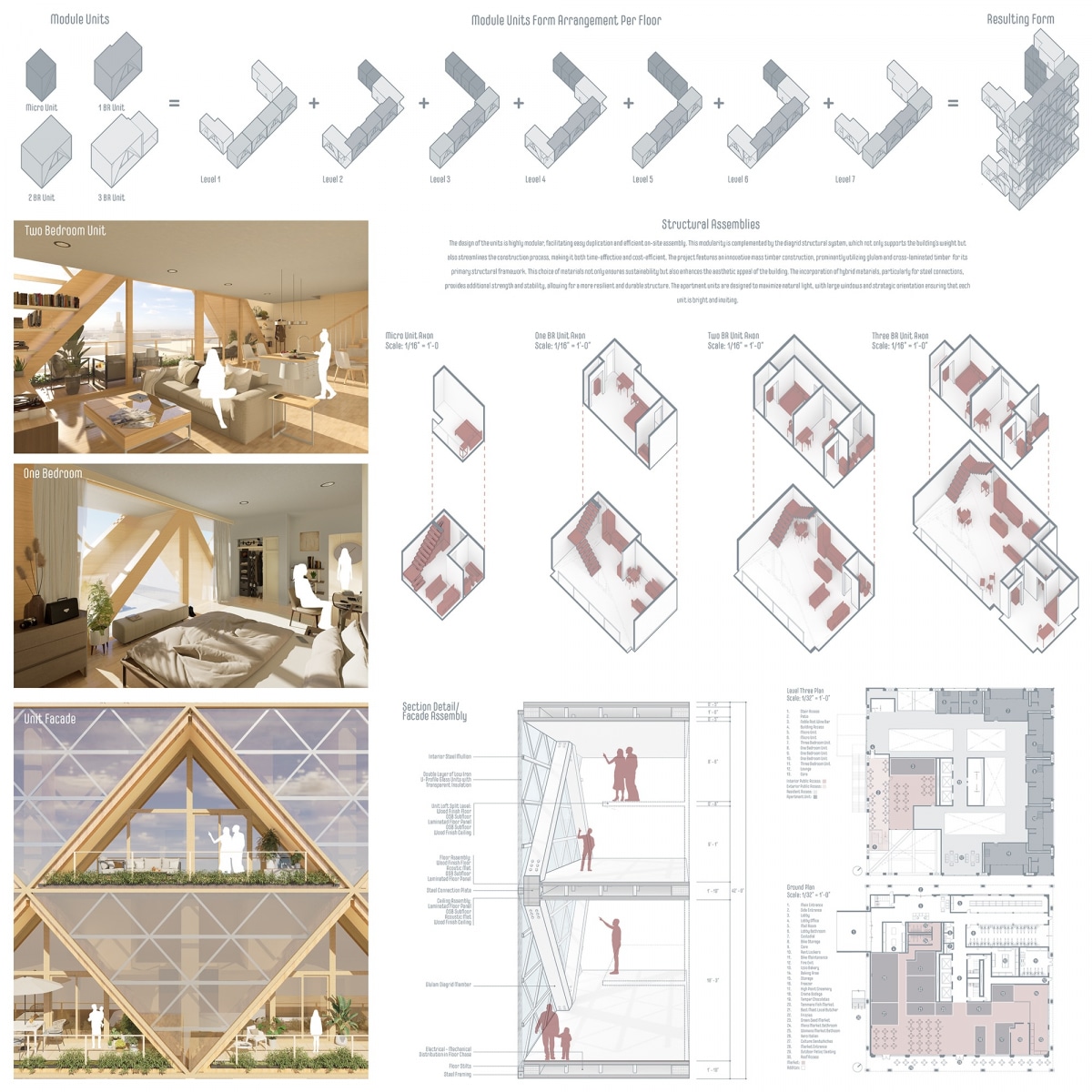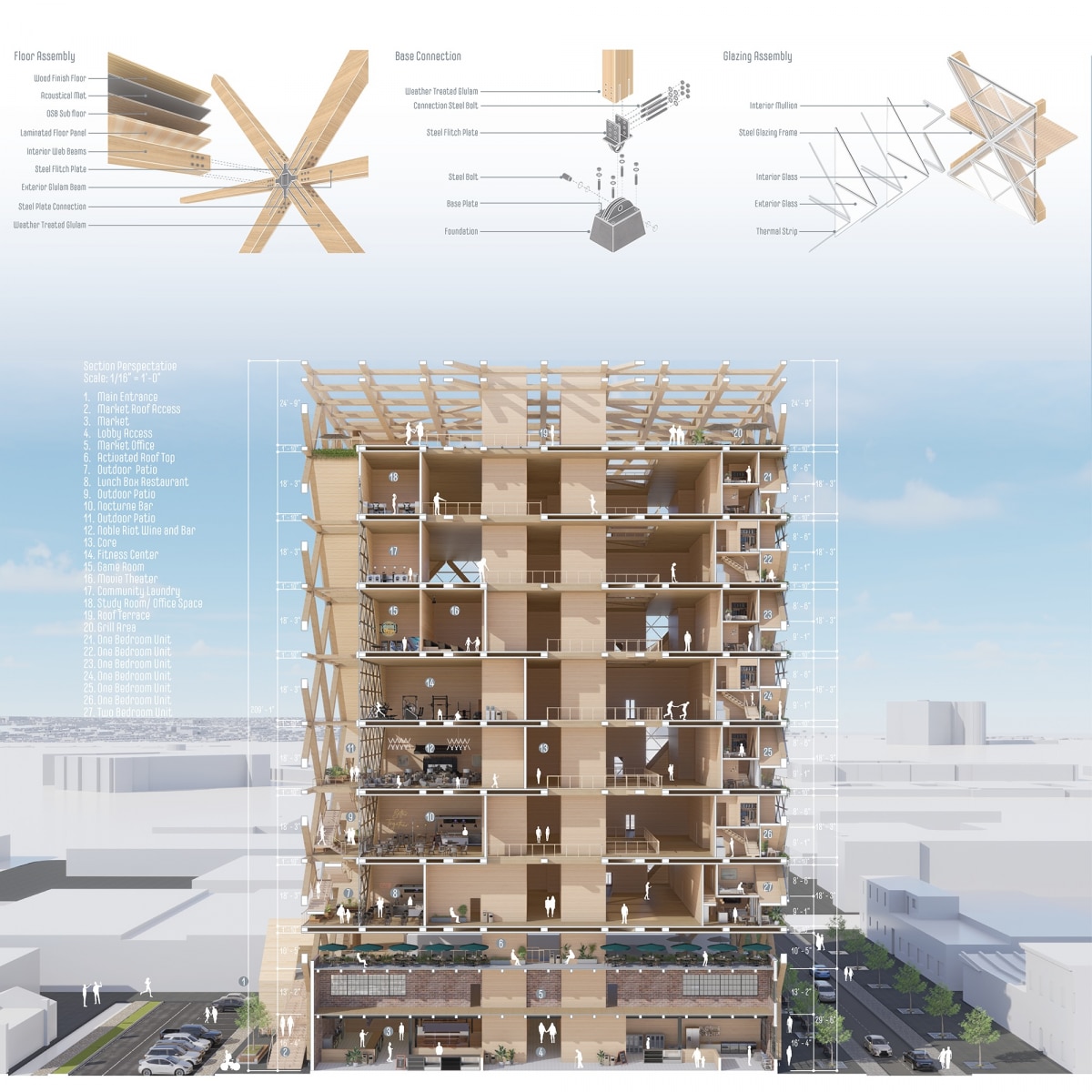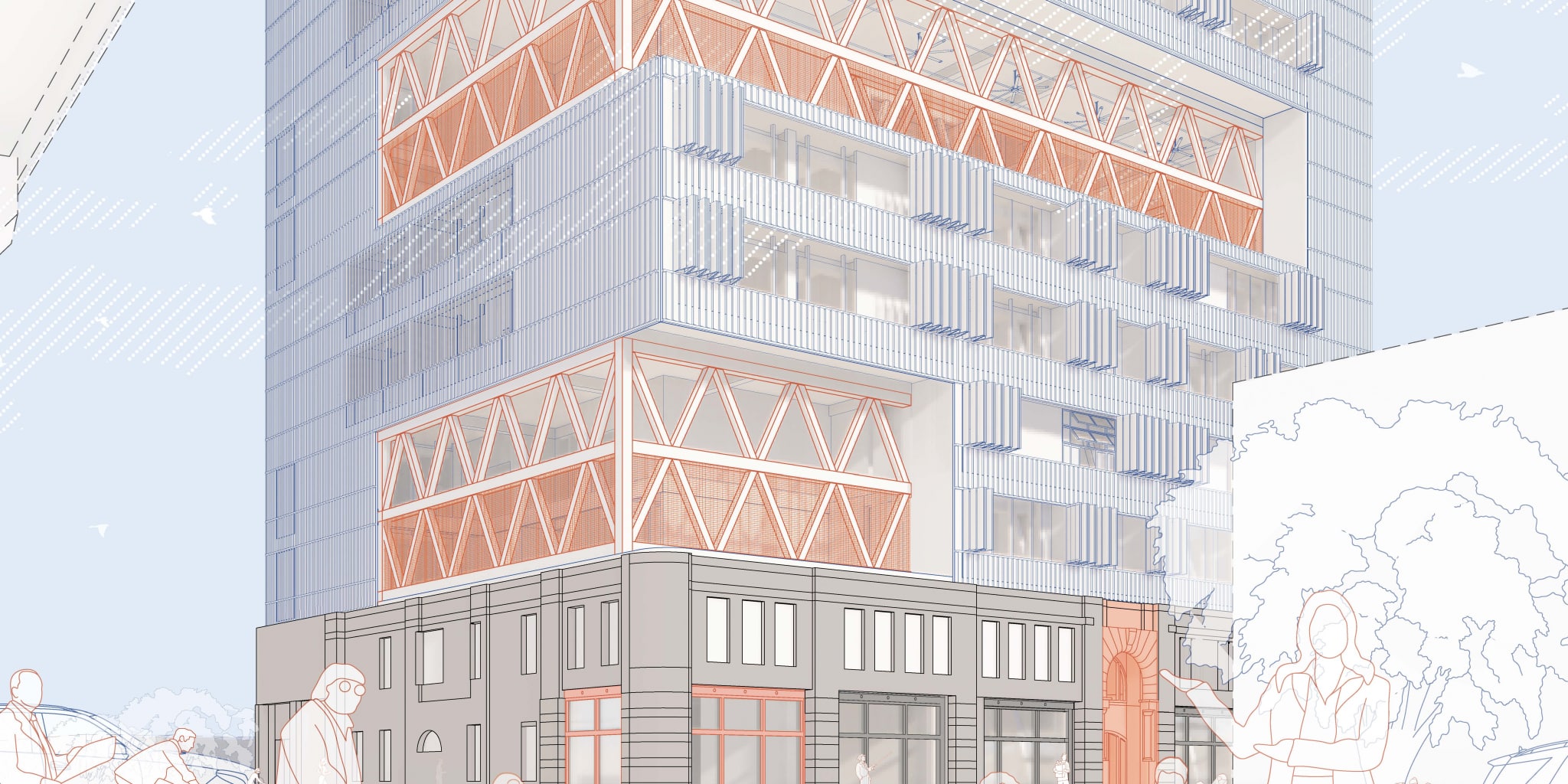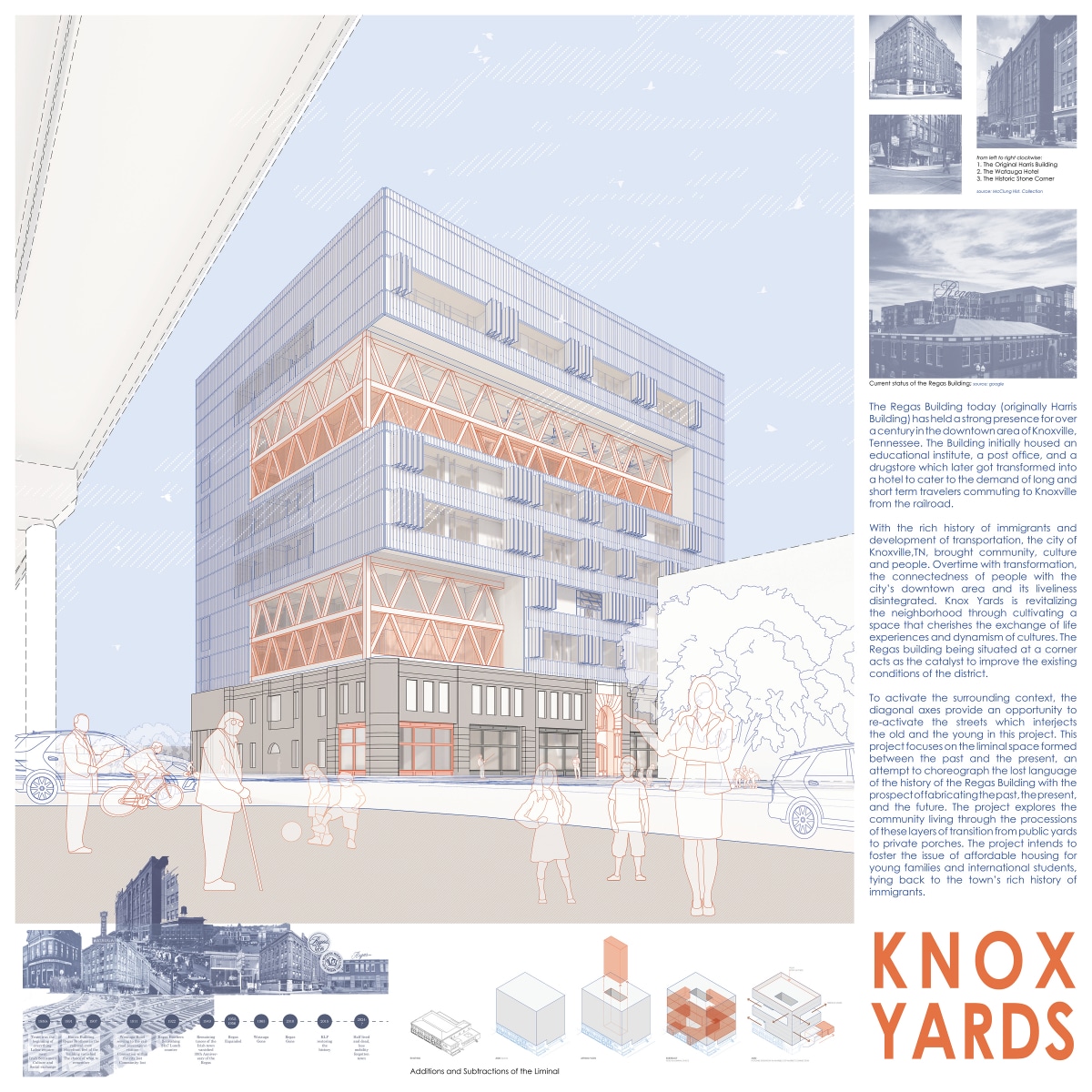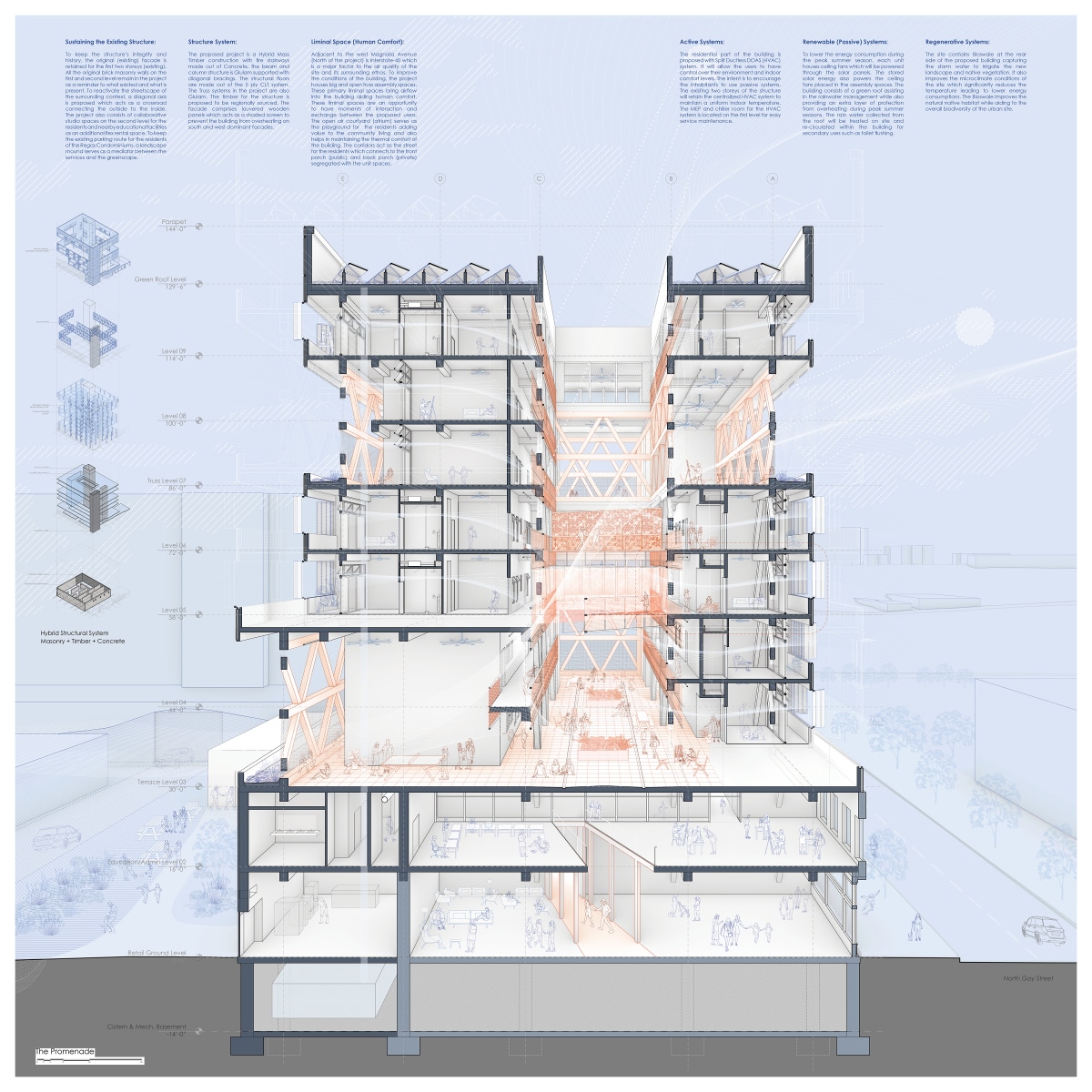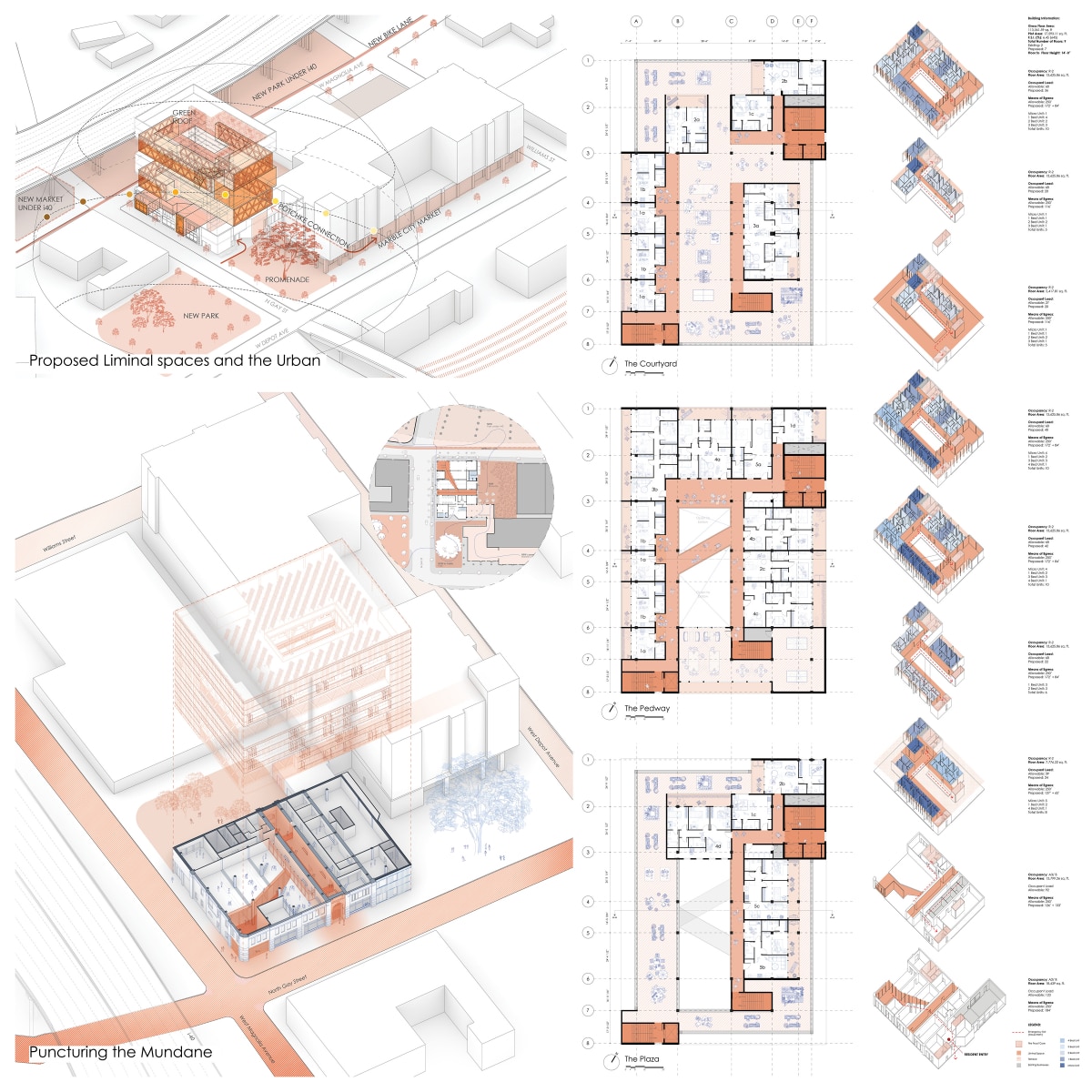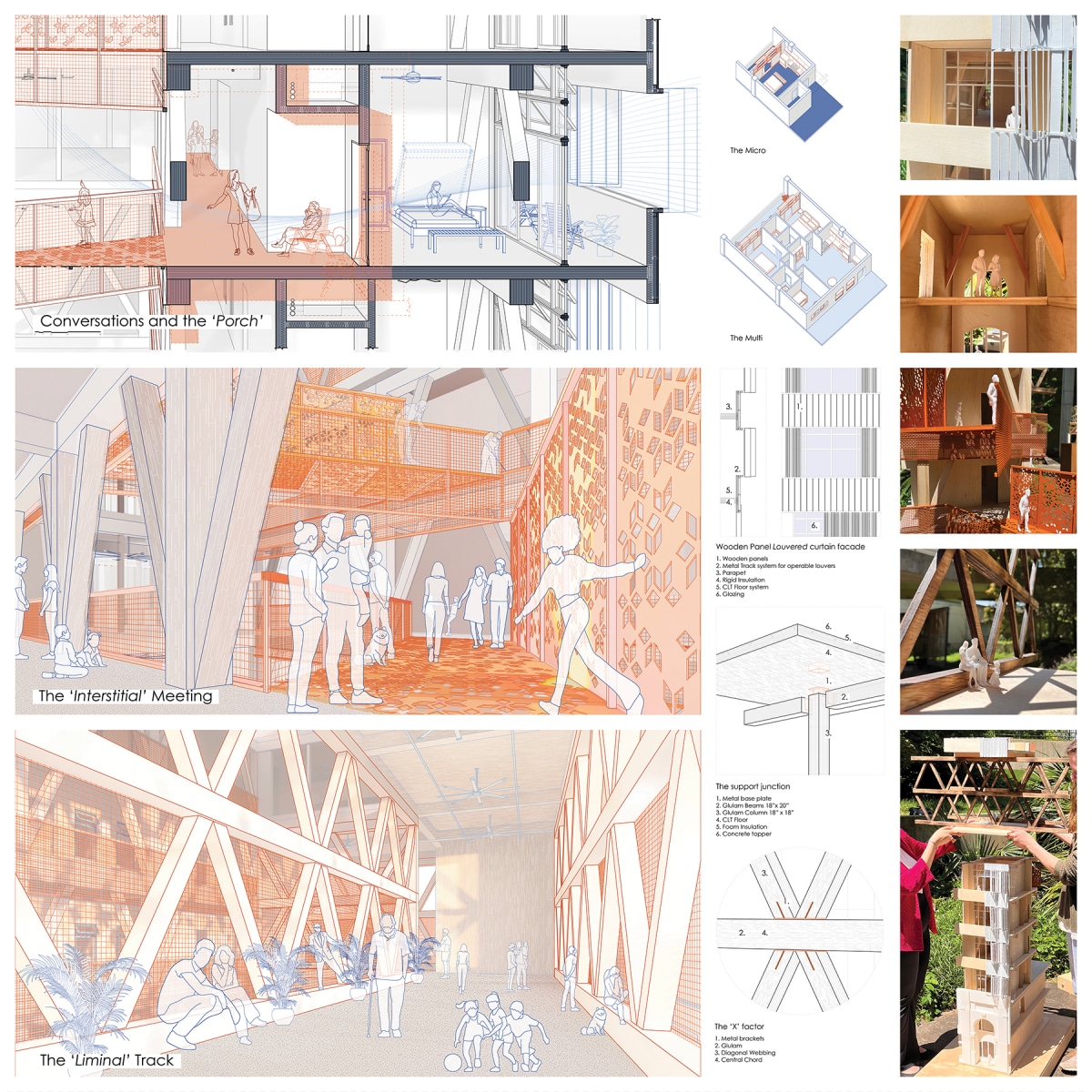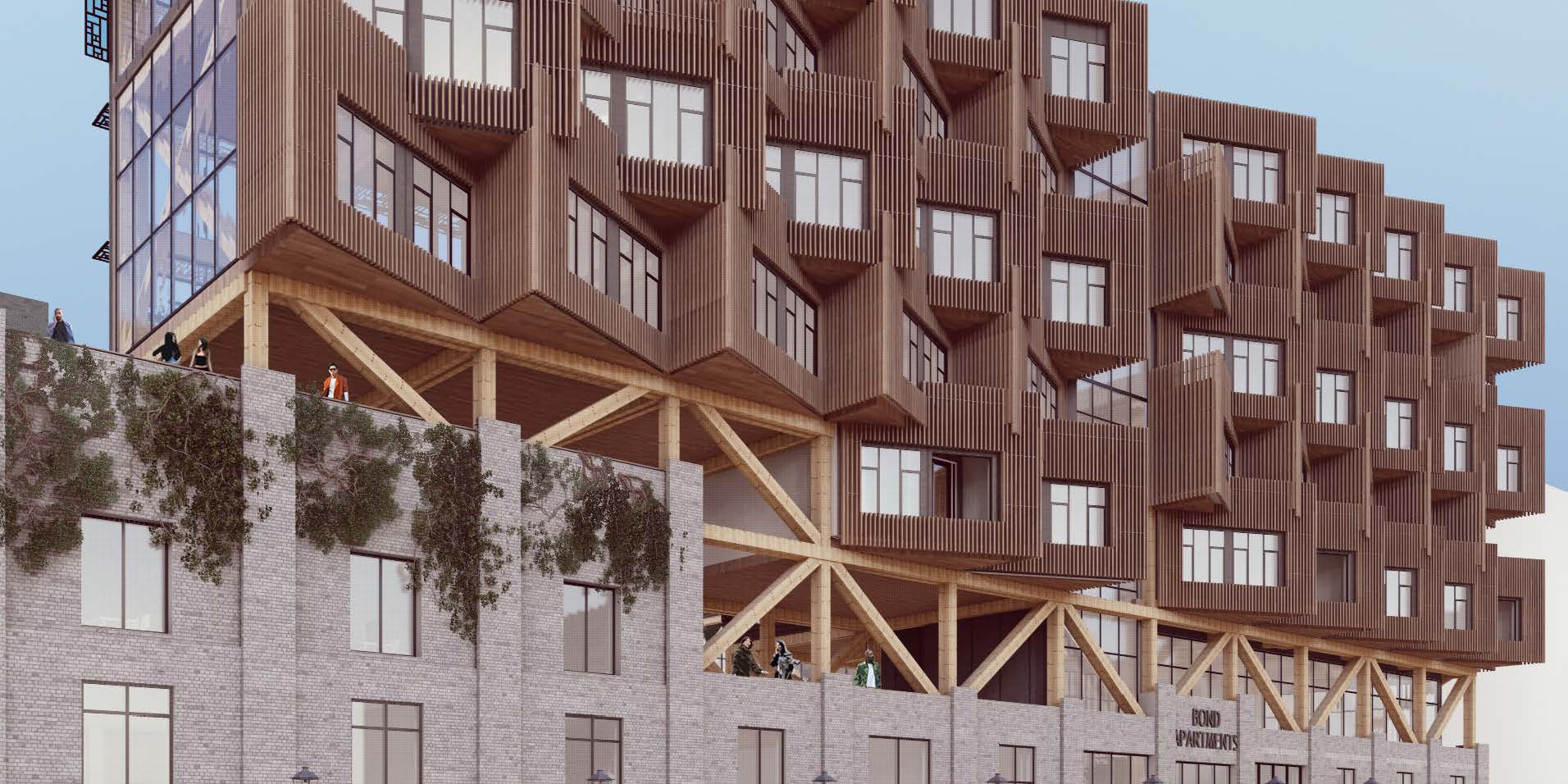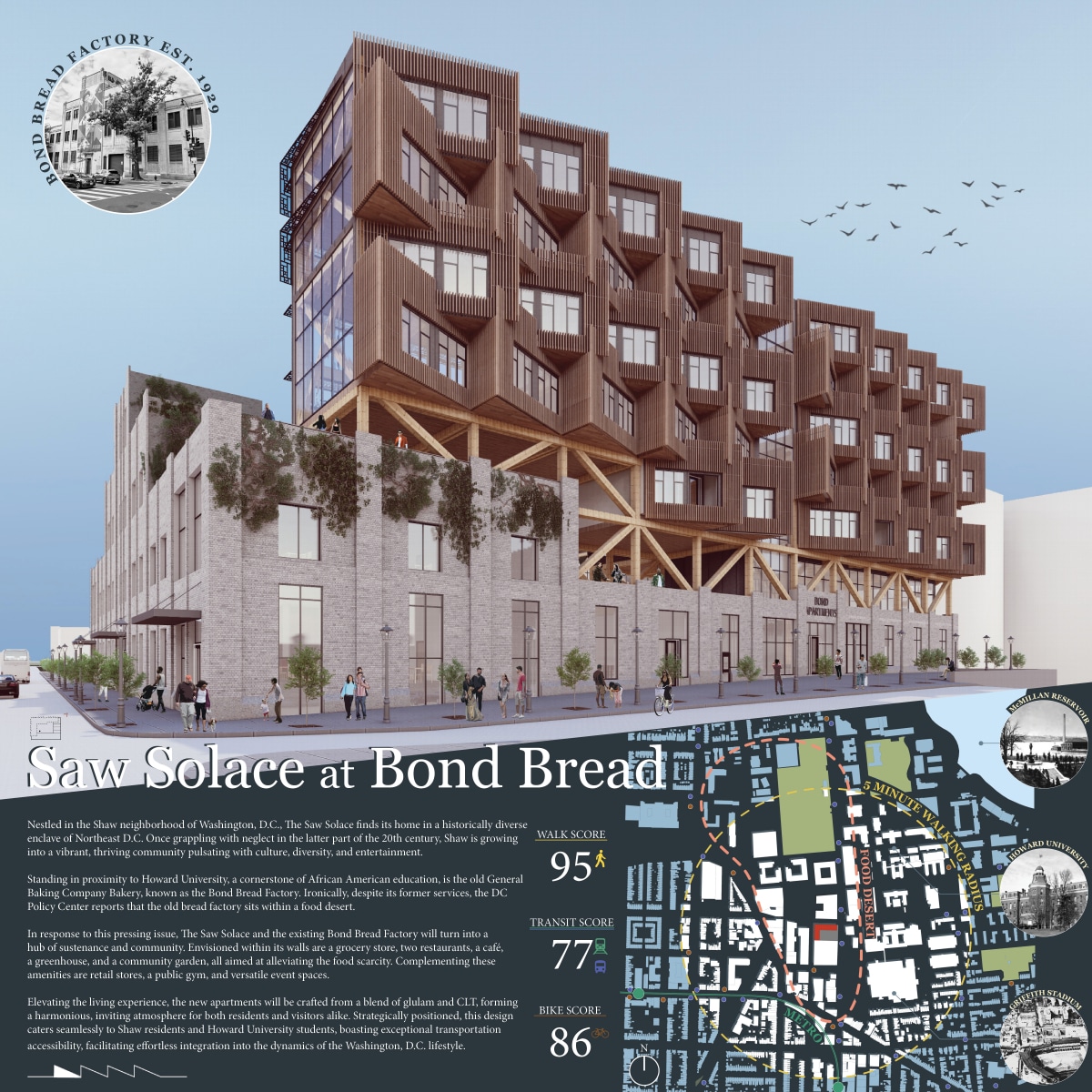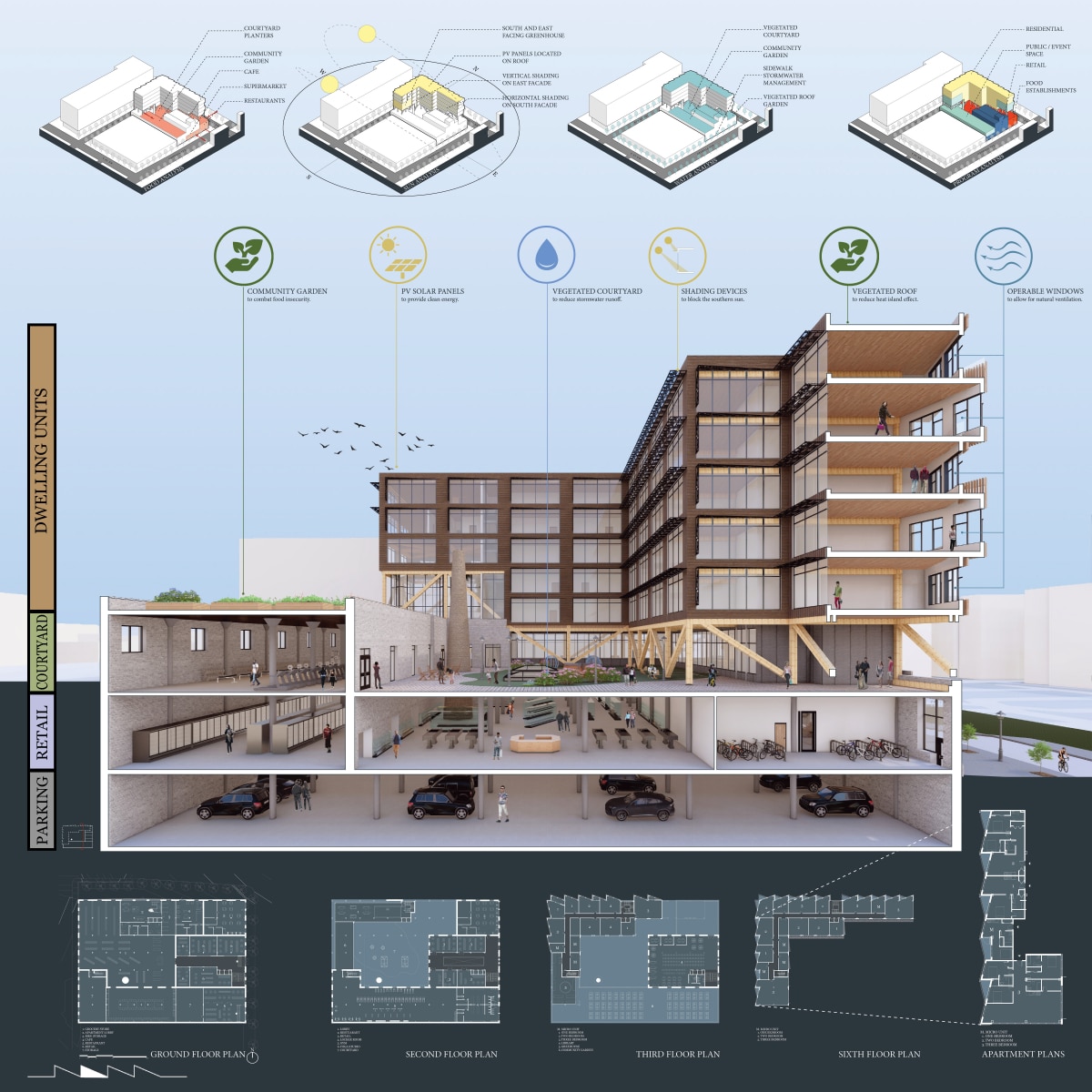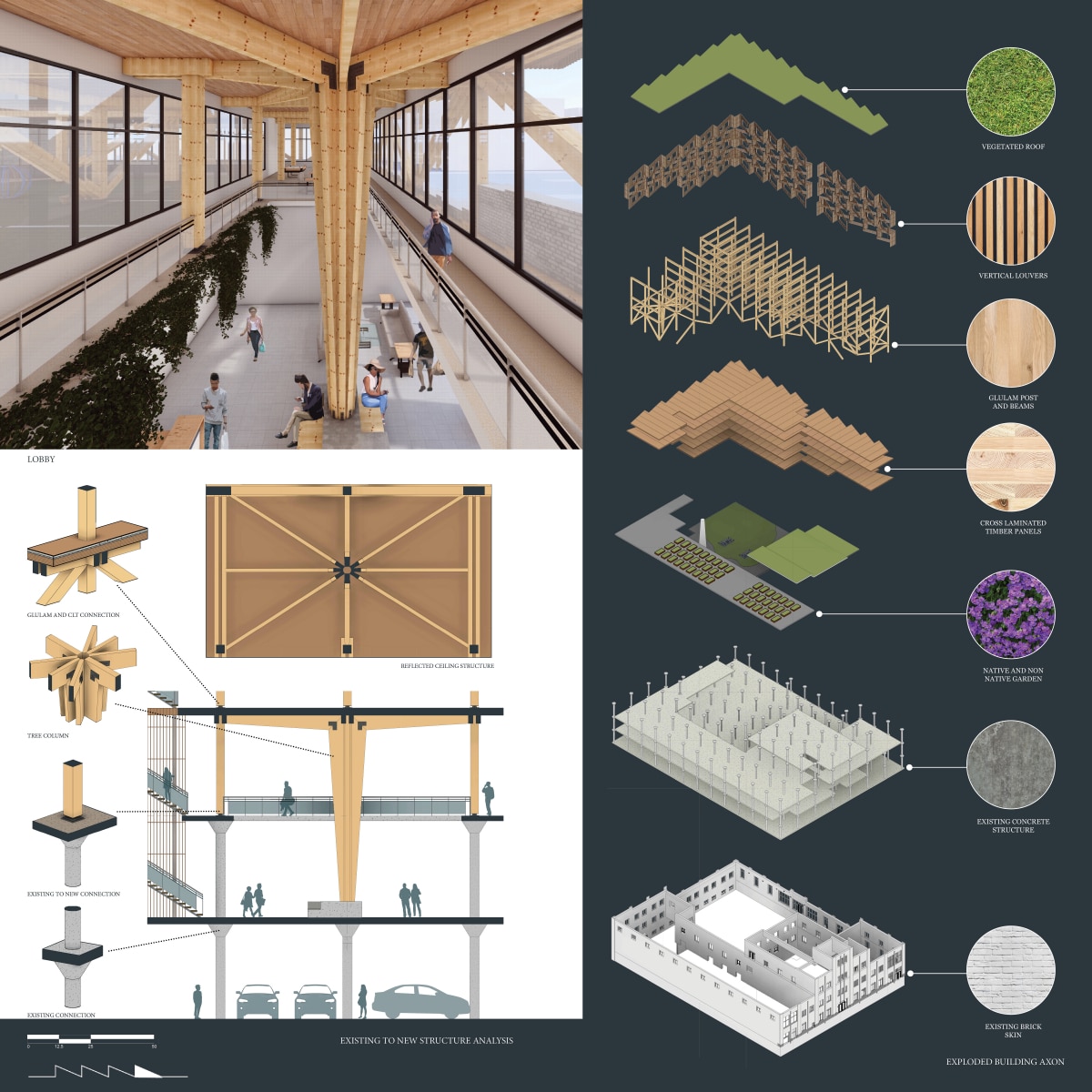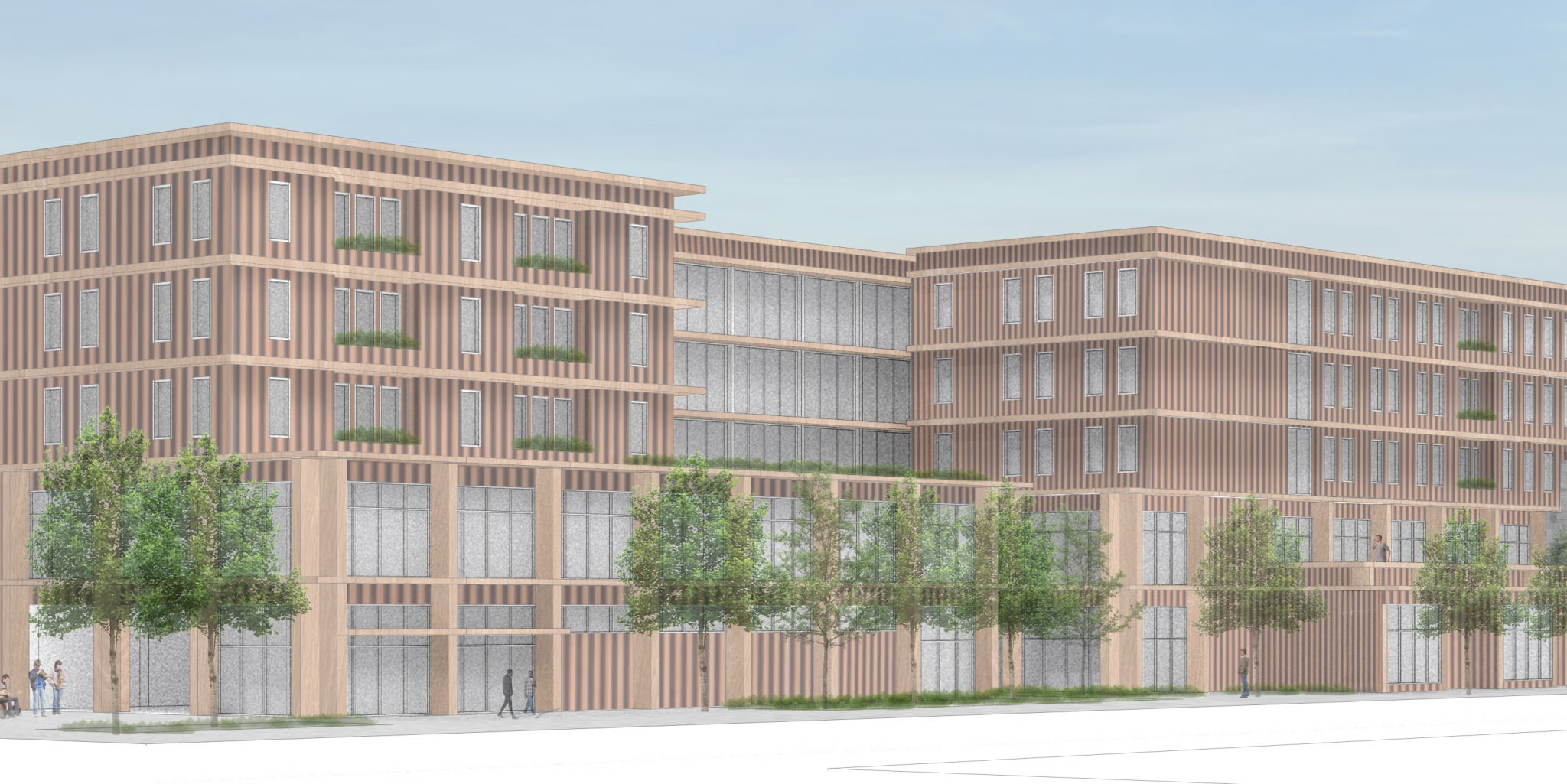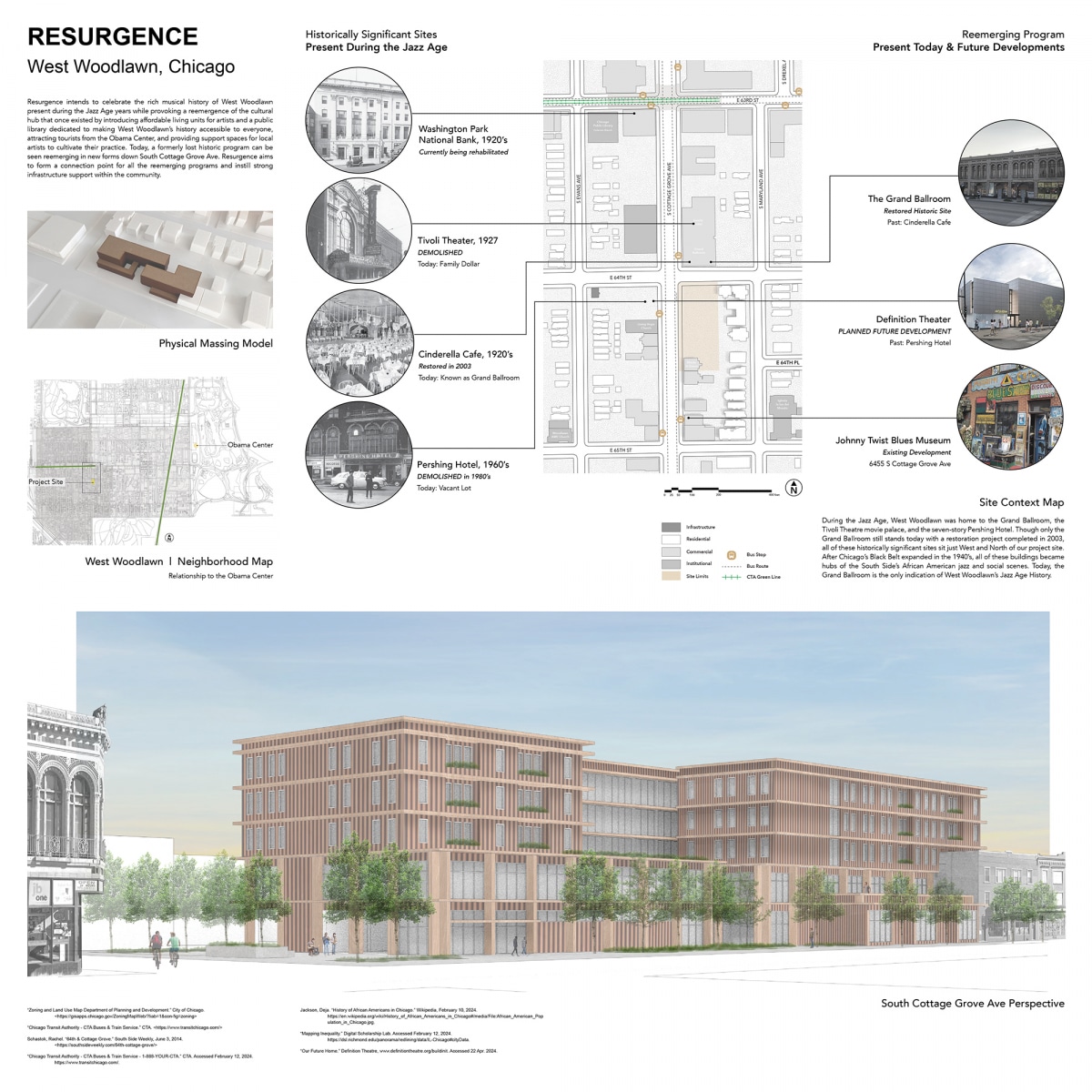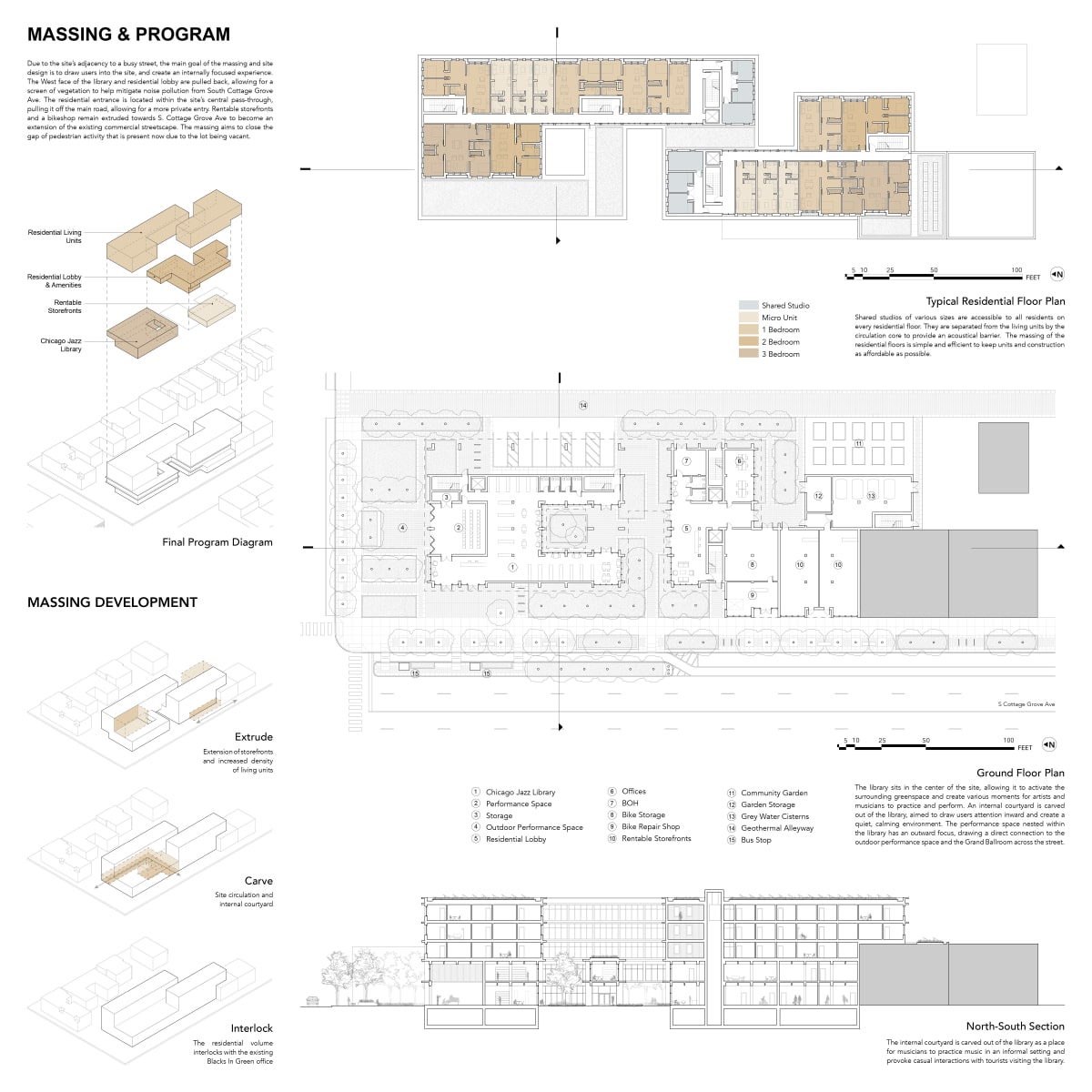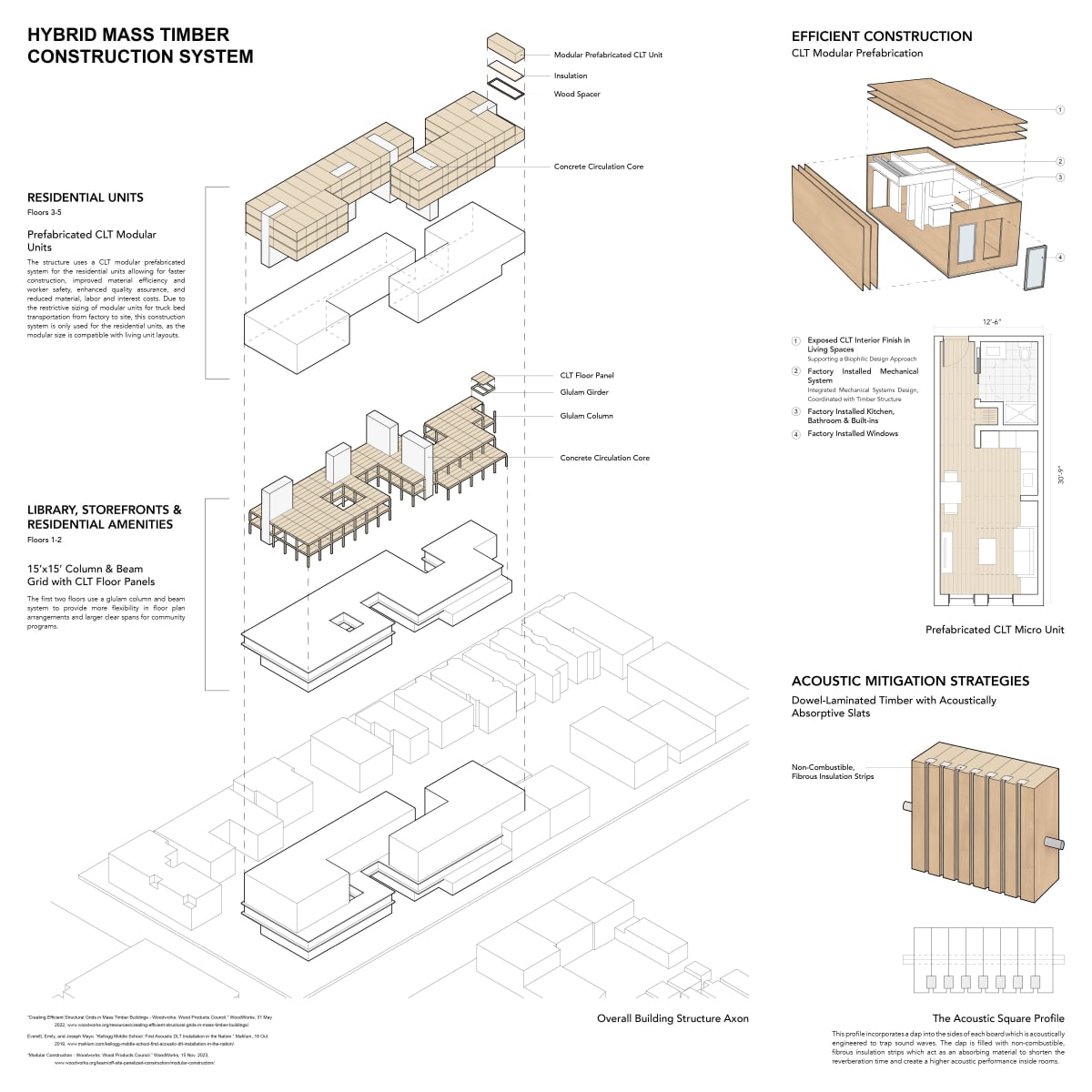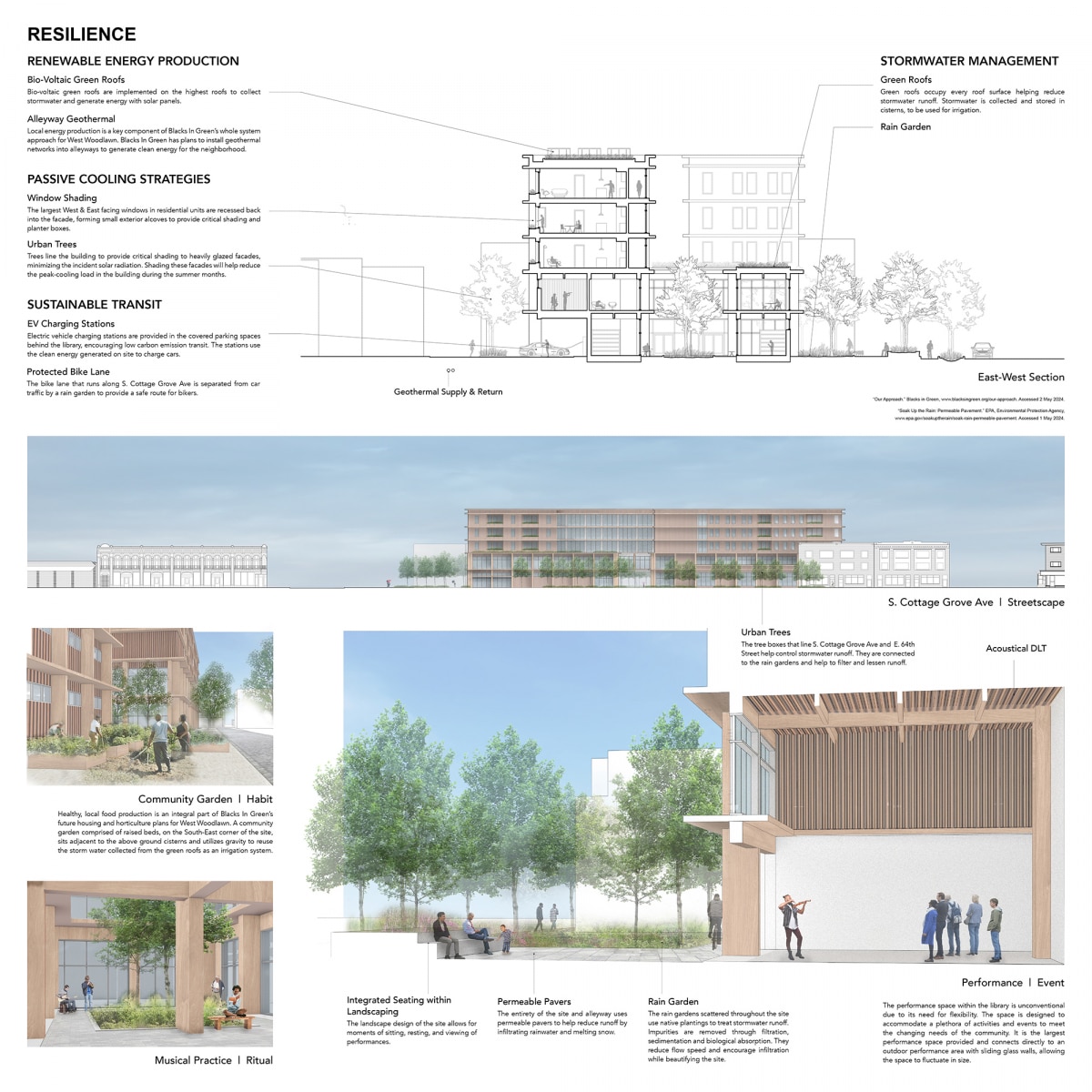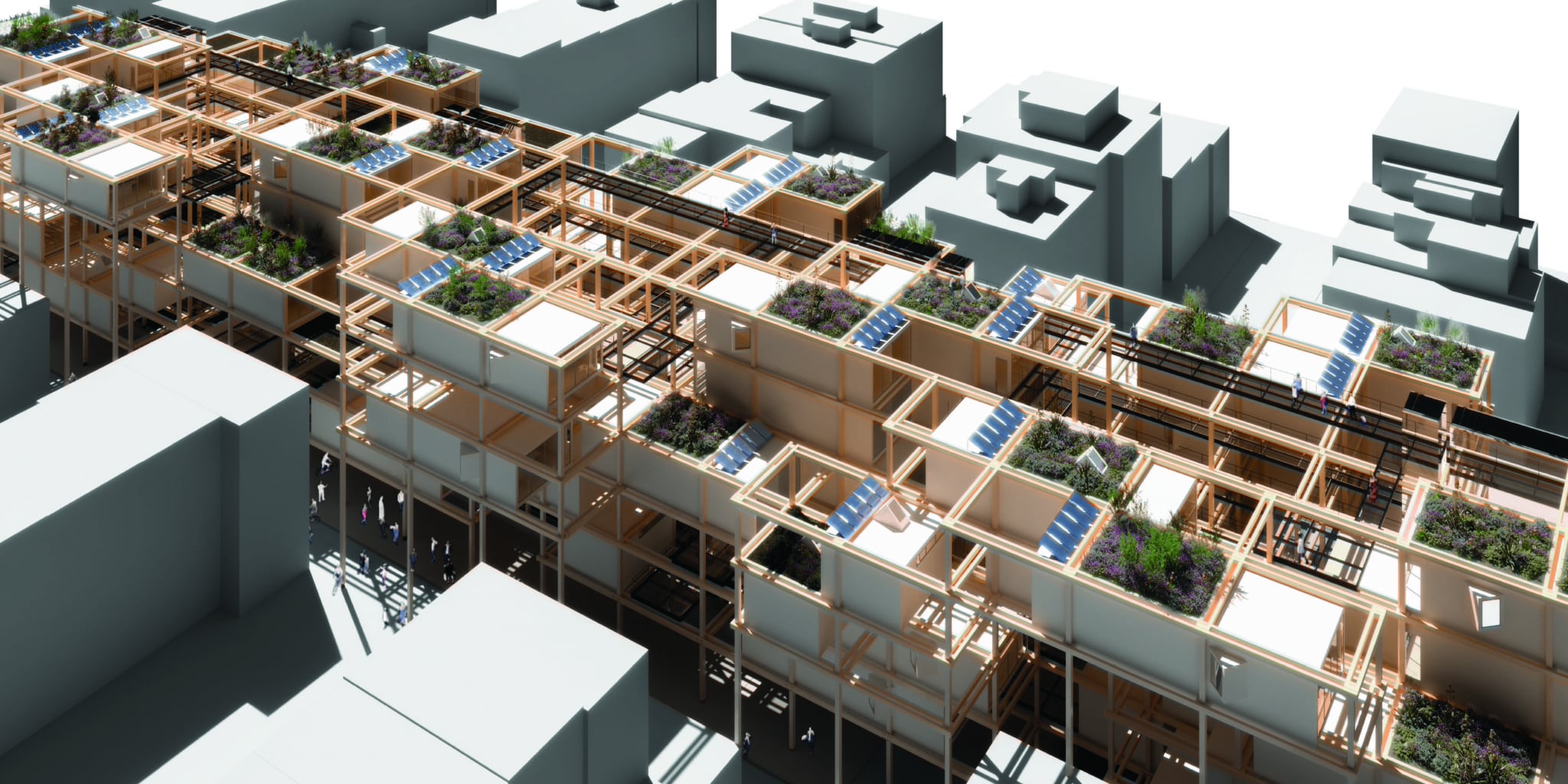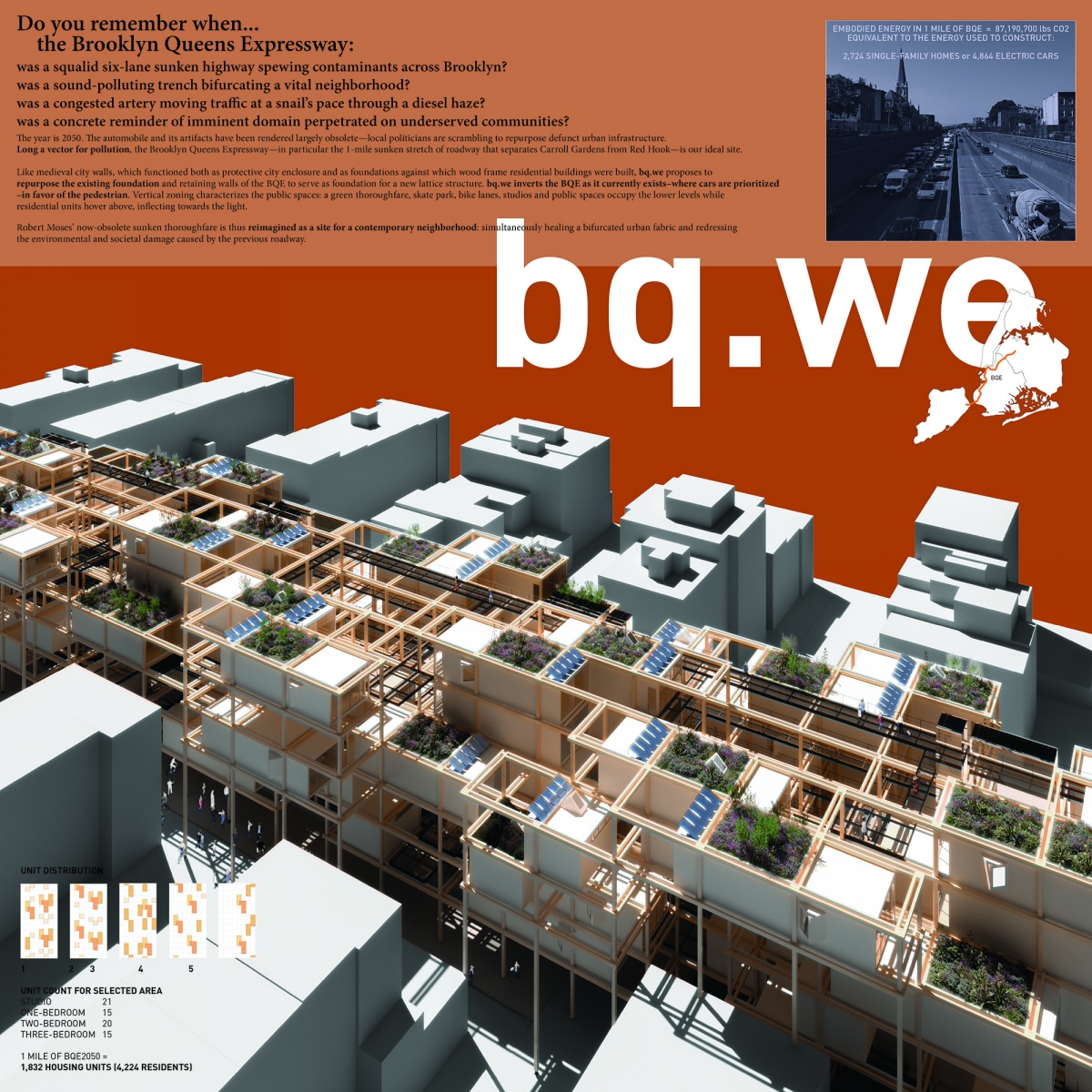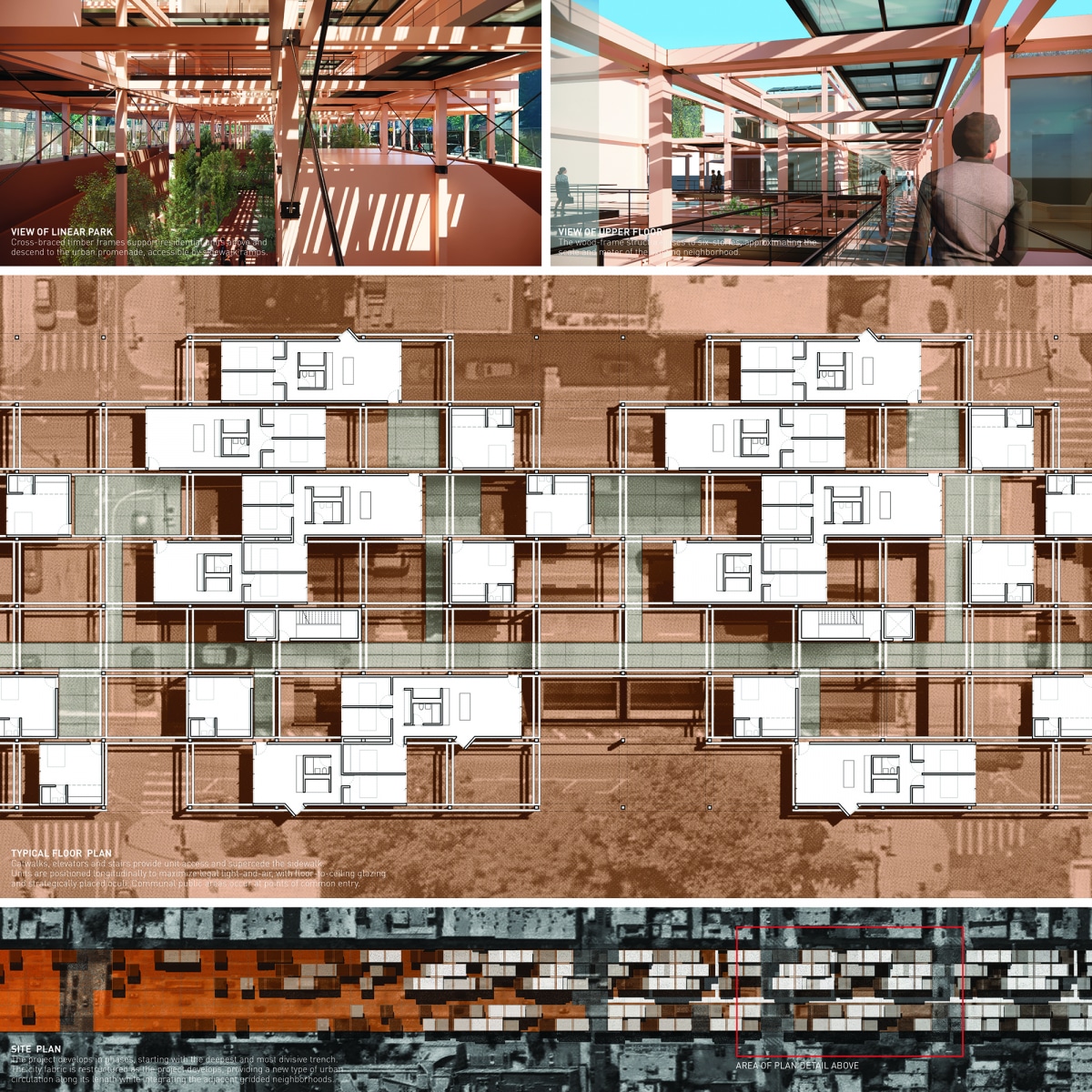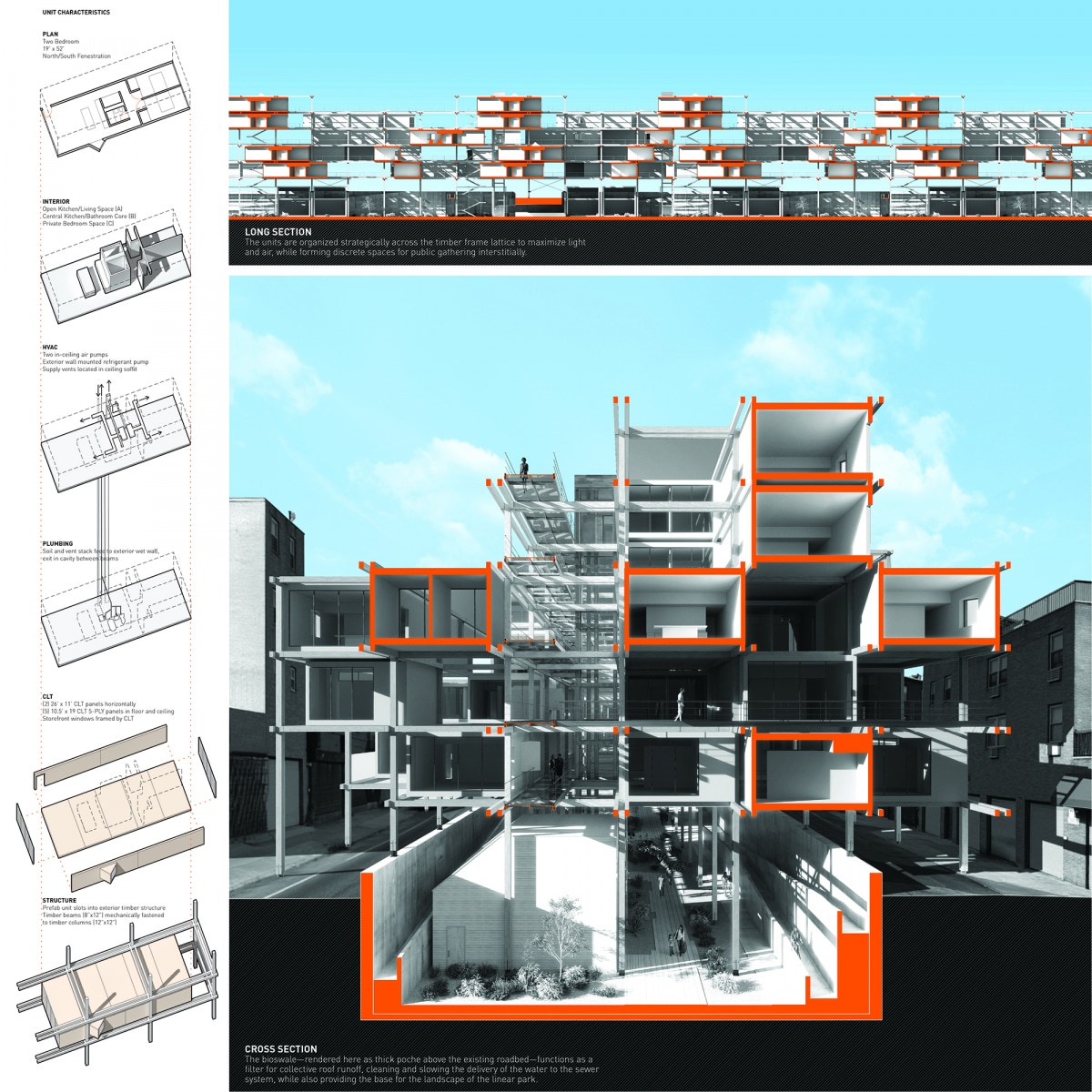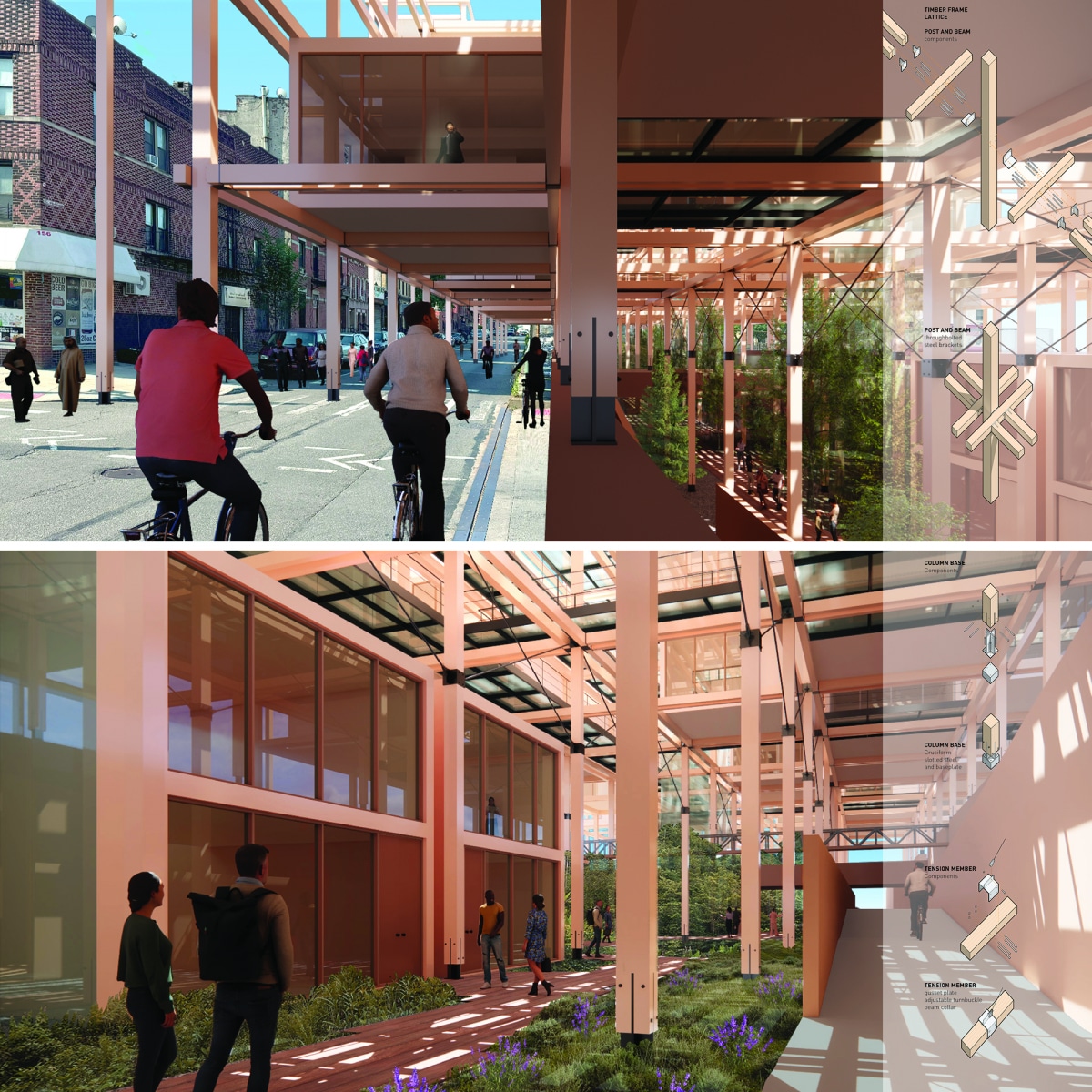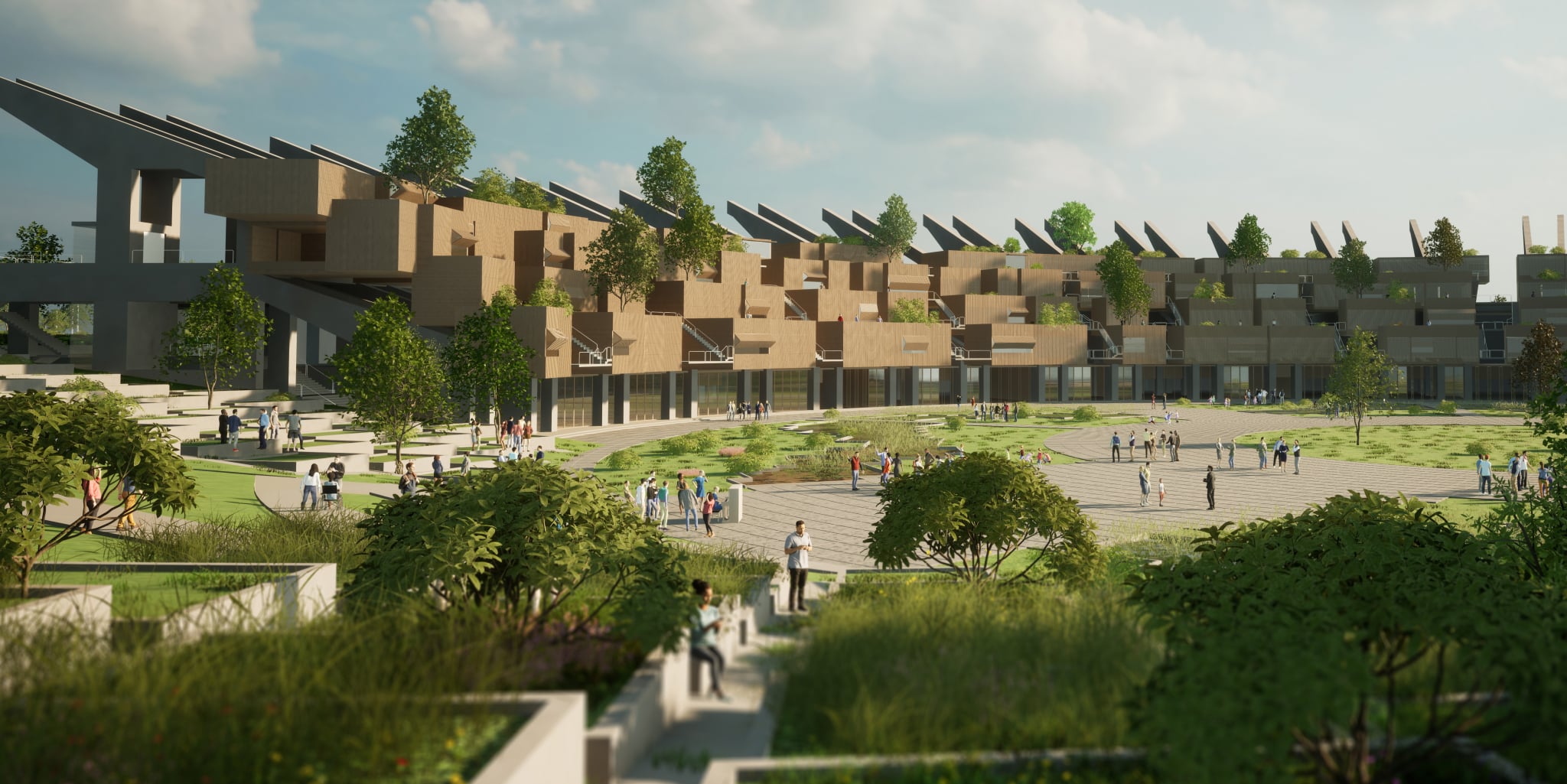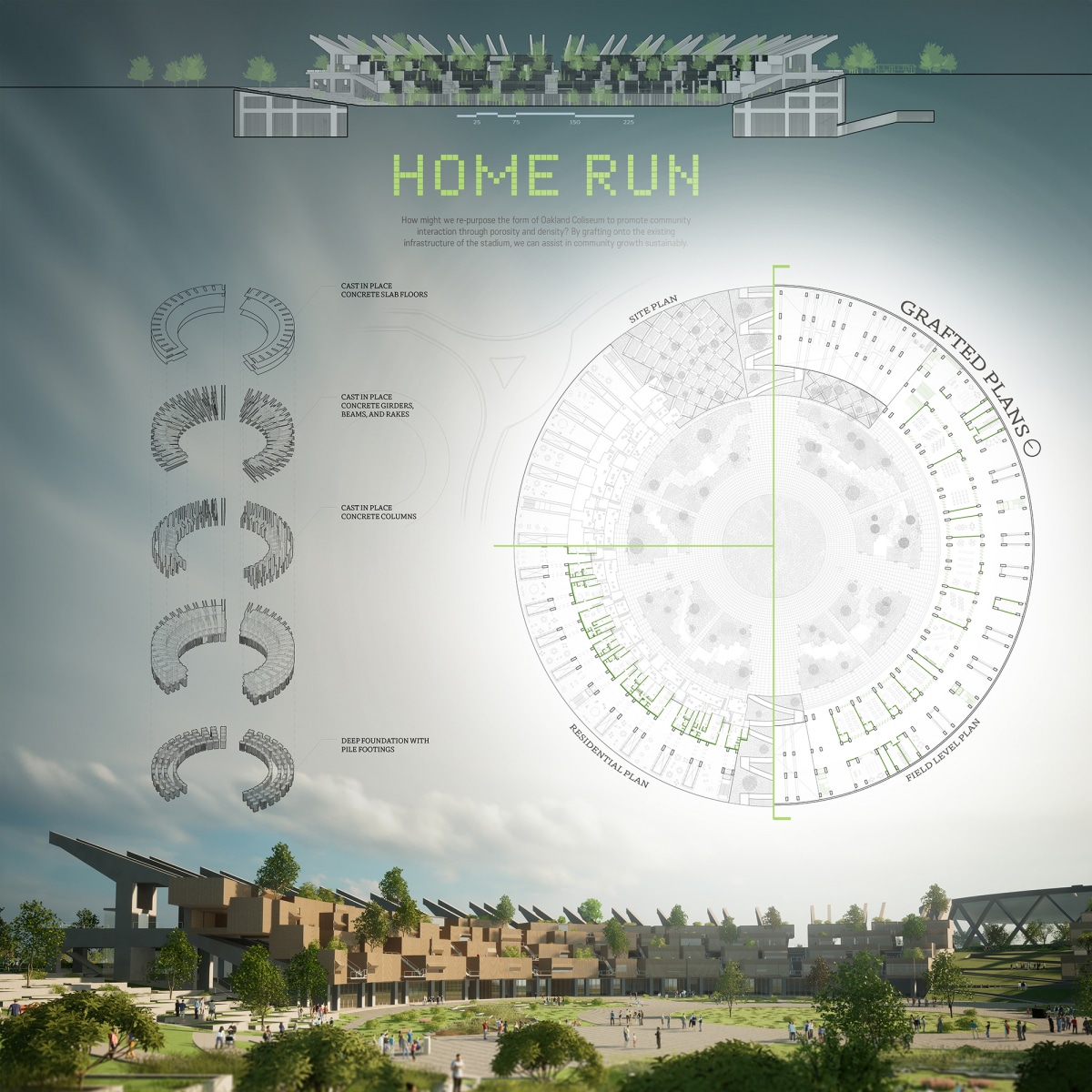Winners Announced
2024 Timber Competition
TIMBER IN THE CITY 5: Urban Habitats Competition
Winners of the 2024 Timber Competition
The Softwood Lumber Board (SLB) and the Association of Collegiate Schools of Architecture (ACSA) are pleased to announce the winners of the Timber in the City 5: Urban Habitats Competition.
The fifth installment of the Timber in the City series, this year’s competition challenged students to devise ways of meeting urban housing needs through the addition of an overbuild, or vertical extension, made of wood to an existing building or structure. Students reimagined our existing cities by using wood systems to design additions that provide more desirable, sustainable, and valuable living and working environments. The seven winning projects demonstrate creative and clear approaches to designing a healthy built environment with timber as a central material, emphasizing the importance of addressing both sustainability and affordability in urban development.
Since 2019, the SLB has funded this competition with the goal of nurturing innate enthusiasm among students for renewable materials and of advancing deeper investigations into wood design at all schools of architecture.
The jurors chose First, Second, Third, Fourth, and Fifth-place winners, along with additional Honorable Mentions. The award recipients of the 2024 Timber in the City 5: Urban Habitats Competition are:
1st Place
MAXX TIMBER: Between Forest and Home
Student: Thomas Gomez Ospina
Faculty Sponsor: Thomas Schaperkotter
Institution: Columbia University
Research Contributor: Peter Osborne, McGill University
Project Description
Can we maximize the housing density of a city without impairing its existing building stock? Can a building maximize its use of timber without diminishing, or even bolstering, the resiliency of the forests from which it is borrowed?
At the convergence of these questions, “MAXX TIMBER: Between Forest and Home” proposes a speculative housing scheme consisting of several wood-based building extensions stretching vertically above an existing NYCHA Housing campus in downtown Brooklyn, New York. Through the design of a replicable housing model that can extend to multiple other sites, the project aims to interrogate both the global commoditization of mass timber as well as the impetus to demolish existing housing.
The project draws its massing from the available unused air rights for the site to maximize its FAR (floor-area ratio) and preserve its OSR (open-space ratio). The final form is carved by studies of solar access, wind patterns, and public circulation to sustain sunlight exposure and air circulation for the existing public parks at ground-level, maintaining the original vision for NYCHA campuses.
To lift the proposed housing additions above the existing block, the new timber structure wraps the existing building with vertical columns braced laterally by balconies that are accessible to existing dwelling units. Functioning as semi-enclosed winter gardens or open terraces, these balconies double as scaffolding during the erection phase to avoid displacing existing NYCHA tenants during construction. The open space between existing NYCHA rooftops and the new extensions creates communal space for old and new residents to use for recreation and potentially growing food to address the food scarcity in areas surrounding NYCHA campuses.
As a speculative endeavor, the project explores the possibility of having every single building material used be wood-based. To maximize the resilience and adaptability of forest ecosystems this design follows a Forest-Building approach1 based on specifying wood to increase the variance of species traits that reflect the diversity of fundamental ecological strategies to cope with known and unknown stressors while maintaining ecological processes and services.
Research Citation:
1 Peter Osborne, Núria Aquilué, Marco Mina, Kiel Moe, Michael Jemtrud, Christian Messier, A trait-based approach to both forestry and timber building can synchronize forest harvest and resilience, PNAS Nexus, Volume 2, Issue 8, August 2023, pgad254, https://doi.org/10.1093/pnasnexus/pgad254
2nd Place
Local Timber
Student: Jarren Amaro
Faculty Sponsor: Peter Raab
Institution: Texas Tech University
Juror Comments: Local Timber is a creative design with elegant use of timber diagrid structure and Y columns that are beautifully detailed. The design also developed the project for sustainable living including a thorough embodied carbon analysis. The project respects the aesthetic and function of the existing building and showcases the capabilities of mass timber design in an urban area.
Project Description
Located within the vibrant heart of Denver’s RiNo district, a new beacon of sustainable urban living rises against the skyline. This innovative housing development isn’t just a collection of apartment units; it’s a visionary approach to urban architecture, weaving together mass timber construction with a commitment to carbon efficiency. From the outset, the project is more than just a series of structures; but it is envisioned to create a living, breathing community where residents could thrive amidst the active and social environment of city life.
Every aspect of the design was meticulously crafted to harmonize with the surrounding urban landscape, seamlessly blending the boundaries between private living and the RiNo District’s active lifestyle. As visitors approach the development, they are greeted by a striking facade that evokes both warmth and sophistication. The extensive use of mass timber not only lends a natural aesthetic to the buildings but also serves as a powerful statement of sustainability. Each beam and member illustrate a story of renewable resources and reduced carbon emissions, embodying the project’s dedication to environmental stewardship.
Inside, residents discover a sanctuary of contemporary living, where every detail has been carefully considered to enhance their quality of life. Spacious, light-filled apartments offer panoramic views of the city skyline, while communal spaces signal the promise of connection and sociality. Whether gathering on the rooftop garden or unwinding in the community lounge, residents find endless opportunities for interaction and engagement. But beyond its aesthetic appeal and modern amenities, the project is a testament to the power of community.
Through collaborative partnerships with local businesses and organizations, the development becomes not just a place to live, but a catalyst for positive change within the neighborhood. From hosting farmers’ markets to community art events, residents actively participate in shaping the future of their urban oasis. In the end, the project transcends the traditional boundaries of urban development. It is more than just a housing project; it is a living, breathing testament to the possibilities of sustainable living and community-centric design.
3rd Place
Knox Yards
Students: Anna Grace Calhoon & Rupan
Faculty Sponsors: Tricia Stuth & Jeremy Magner
Institution: University of Tennessee-Knoxville
Project Description
The Regas Building today (originally Harris Building) has held a strong presence for over a century in the downtown area of Knoxville, Tennessee. The Building initially housed an educational institute, a post office, and a drugstore which later got transformed into a hotel to cater to the demand of long and short term travelers commuting to Knoxville from the railroad.
With the rich history of immigrants and development of transportation, the city of Knoxville,TN, brought community, culture and people. Overtime with transformation, the connectedness of people with the city’s downtown area and its liveliness disintegrated. Knox Yards is revitalizing the neighborhood through cultivating a space that cherishes the exchange of life experiences and dynamism of cultures. The Regas building being situated at a corner acts as the catalyst to improve the existing conditions of the district.
To activate the surrounding context, the diagonal axes provide an opportunity to re-activate the streets which interjects the old and the young in this project. This project focuses on the liminal space formed between the past and the present, an attempt to choreograph the lost language of the history of the Regas Building with the prospect of fabricating the past, the present, and the future. The project explores the community living through the processions of these layers of transition from public yards to private porches. The project intends to foster the issue of affordable housing for young families and international students, tying back to the town’s rich history of immigrants.
4th Place
Saw Solace at Bond Bread
Students: Sarah Jane Graven & Megan Bugbee
Faculty Sponsor: Peter Noonan
Institution: University of Maryland
Project Description
Nestled in the Shaw neighborhood of Washington, D.C., The Saw Solace finds its home in a historically diverse enclave of Northeast D.C. Once grappling with neglect in the latter part of the 20th century, Shaw is growing into a vibrant, thriving community with culture, diversity, and entertainment.
Standing in proximity to Howard University, a cornerstone of African American education, is the old General Baking Company Bakery, known as the Bond Bread Factory. Ironically, despite its former services, the DC Policy Center reports that the old bread factory sits within a food desert.
In response to this pressing issue, The Saw Solace and the existing Bond Bread Factory will turn into a hub of sustenance and community. Envisioned within its walls are a grocery store, two restaurants, a café, a greenhouse, and a community garden, all aimed at alleviating the food scarcity. Complementing these amenities are retail stores, a public gym, and versatile event spaces.
Elevating the living experience, the new apartments will be crafted from a blend of glulam and CLT, forming a harmonious, inviting atmosphere for both residents and visitors alike. Strategically positioned, this design caters seamlessly to Shaw residents and Howard University students, boasting exceptional transportation accessibility, facilitating effortless integration into the dynamic Washington, D.C. lifestyle.
5th Place
Resurgence
Student: Allie Wickman
Faculty Sponsors: Uthman Olowa & Ellen Grimes
Institution: School of the Art Institute of Chicago
Juror Comments: Resurgence is a considerate and sensitive design for the surrounding neighborhood. The massing of the floors provides an efficient way to maintain construction affordability. The simplicity and rationality of the design highlights the capabilities of mass timber to deliver a clean design aesthetic that draws on the prefabricated nature of the material.
Project Description
Resurgence, a net-zero mixed-use project for a community-based environmental justice organization in Chicago’s West Woodlawn neighborhood, combines affordable housing with an innovative music library to resist displacement in an African-American neighborhood threatened by gentrification. It celebrates the rich musical history of West Woodlawn’s Jazz Age era and catalyzes the reemergence of the cultural hub that once existed at this historic site. Resurgence provides affordable living units for artists and musicians, along with a public library dedicated to making West Woodlawn’s musical history accessible to everyone. The library operates as a social condenser, attracting tourists from the nearby Obama Presidential Center while providing support spaces for local artists to cultivate their practices. The project aims to demonstrate how green infrastructure and a thoughtful use of mass timber can contribute to the sustainability of an African American community with a long history of social and cultural innovation.
Located on a busy commercial street, the building’s massing and landscaping draws users into the site to create an internally focused experience. The West facade of the library and residential lobby are setback, allowing for a screen of vegetation that mitigates noise and air pollution from the street. New storefronts and a bike shop on the first floor become an extension of the existing commercial streetscape of S. Cottage Grove Ave. This integrated approach to massing, programming and site design encourages pedestrian activity by closing the gaps in the streetscape caused by decades of racist disinvestment which lead to extensive demolition of commercial buildings and other neighborhood infrastructure.
Shared studios of various sizes are accessible to all residents on every residential floor. They are separated from the living units by the circulation core to provide an acoustical barrier. The design of the residential floors is simple and efficient to keep construction and units as affordable as possible.
The program primarily consists of affordable housing for artists and musicians. Accompanying the housing is a public library dedicated to Chicago’s jazz music history, with concentration on the history present in West Woodlawn. The library includes performance and practice spaces provided for emerging artists. The secondary community program is rentable storefronts alongside S. Cottage Grove Ave, owned and managed by a local environmental justice organization, Blacks In Green. Located at the back of the site, adjacent to the shared community garden, there is space dedicated for green infrastructure systems and equipment on the ground floor level and the basement.
Honorable Mention
bq.we
Students: Ana Bulacovschi, Ellis Donahue, Viktor Nakev & Martin Parra
Faculty Sponsor: Philippe Baumann
Institution: Pratt Institute
Project Description
The year is 2050. The automobile and its artifacts have been rendered largely obsolete—local politicians are scrambling to repurpose defunct urban infrastructure.
Long a vector for pollution, the Brooklyn Queens Expressway—in particular the 1-mile sunken stretch of roadway that separates Carroll Gardens from Red Hook—is our ideal site.
Like medieval city walls, which functioned both as protective city enclosure and as foundations against which wood frame residential buildings were built, bq.we proposes to repurpose the existing foundation and retaining walls of the BQE to serve as foundation for a new lattice structure.
bq.we inverts the BQE as it currently exists–where cars are prioritized–in favor of the pedestrian.
Vertical zoning characterizes the public spaces: a green thoroughfare, skate park, bike lanes, studios and public spaces occupy the lower levels while residential units hover above, inflecting towards the light.
Robert Moses’ now-obsolete sunken thoroughfare is thus reimagined as a site for a contemporary neighborhood: simultaneously healing a bifurcated urban fabric and redressing the environmental and societal damage caused by the previous roadway.
Honorable Mention
Home Run
Students: Andy Vo, Eli Melendez & Sara Lee
Faculty Sponsor: Michael Hamilton
Institution: University of Nebraska-Lincoln
Project Description
The project questions how we might re-purpose the existing Oakland Coliseum to promote community interaction through porosity and density. A vertical expansion made of mass timber provides the opportunity to create a socially, economically, and environmentally sustainable building that rethinks how the Coliseum could be used. The stadium typology is challenged to extend its resilience from one program use to another over generations.
CLT is the material of choice for the grafted structure to be added onto the existing cast in place concrete frame. Modular assembly of residential and commercial units provides ease of construction and reduces time and costs as it can be prefabricated and assembled on site.
The project CLT modular design grafted into the existing structure creates a series of third spaces and micro urbanism. Residential modular units are arranged around circulation voids that echo the experience of traveling to the grandstands at a baseball game. The third space voids that are created allow for daylight and ventilation and promote community growth and gathering. At the field level, community focused programs are provided to achieve a viable proposition for affordable housing. Food, education, markets, and libraries are all programmed to create a flourishing community. Areas of the field level concourse are left intentionally blank for future development and are intended to be programmed by the residents themselves to determine needs.
The grafting of one thing into another continues after construction as the community grafts itself into the building in which they reside.
Jury
The jury for the 2024 Timber Competition includes:

Omar Al-Hassawi
Washington State University

Erik Barth
Wentworth Institute of Technology/Gensler

Veronica Madonna
Athabasca University
Participating Schools
The competition had over 600 participants from the following schools:
Auburn University, Ball State University, Boston Architectural College, California Baptist University, California Polytechnic State University, California State Polytechnic University, Pomona, Columbia University, Florida Agricultural and Mechanical University, Florida Atlantic University, Georgia Institute of Technology, Harvard University, Kean University, Keene State College, Kent State University, Madison College, Marywood University, Midlands Technical College, New Jersey Institute of Technology, New York Institute of Technology, NewSchool of Architecture and Design, North Carolina State University, Oklahoma State University, Parsons School of Design, Prairie View A&M University, Pratt Institute, Savannah College of Art and Design, School of the Art Institute of Chicago, Syracuse University, Texas A&M University, Texas Tech University, Thomas Jefferson University, University of California, Berkeley, University of Florida, University of Houston, University of Illinois, Urbana-Champaign, University of Kansas, University of Maryland, University of Memphis, University of Michigan, University of Nebraska-Lincoln, University of Nevada, Las Vegas, University of New Mexico, University of Pennsylvania, University of Tennessee-Knoxville, University of Texas at Arlington, University of Texas at Austin, University of the District of Columbia, University of Toronto, University of Utah
Competition Organizers & Sponsors
Questions
Edwin Hernández-Ventura
Programs Coordinator
ehernandez@acsa-arch.org
202.785.2324
Eric W. Ellis
Senior Director of Operations and Programs
eellis@acsa-arch.org
202-785-2324

 Study Architecture
Study Architecture  ProPEL
ProPEL 